new posts in all blogs
Viewing: Blog Posts Tagged with: BlogBookTour, Most Recent at Top [Help]
Results 26 - 50 of 264
How to use this Page
You are viewing the most recent posts tagged with the words: BlogBookTour in the JacketFlap blog reader. What is a tag? Think of a tag as a keyword or category label. Tags can both help you find posts on JacketFlap.com as well as provide an easy way for you to "remember" and classify posts for later recall. Try adding a tag yourself by clicking "Add a tag" below a post's header. Scroll down through the list of Recent Posts in the left column and click on a post title that sounds interesting. You can view all posts from a specific blog by clicking the Blog name in the right column, or you can click a 'More Posts from this Blog' link in any individual post.
I rarely feature a book twice, but I couldn't pass up the opportunity to share Abigail Halpin's post about her method in creating FINDING WILD. So please give her a warm welcome...
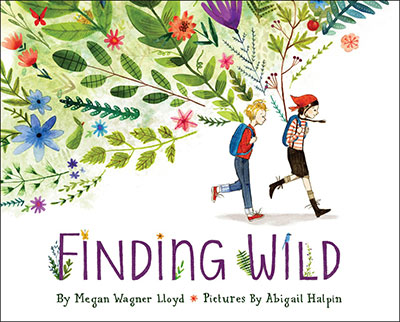
Creating FINDING WILD
by Abigail Halpin The very first thing that struck me about the manuscript for Finding Wild was just how wild it in fact was. The story felt immediate, spontaneous and organic, and going into the artwork, I knew I wanted to capture those qualities.
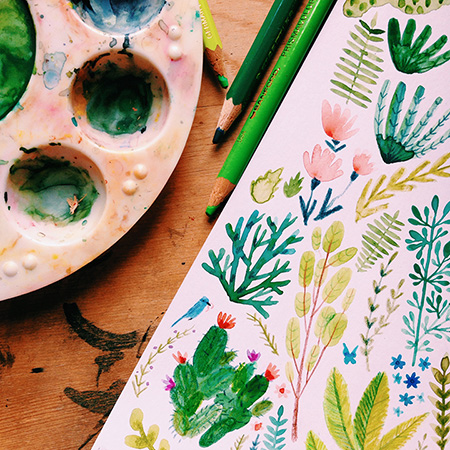
For the book's artwork, I worked in a combination of watercolor, graphite and colored pencil, with some digital finishing. Watercolor can be delightfully unpredictable (just like nature), so it felt right for the story. I added in colored pencils to give some texture and roughness, to balance out the softness of the watercolors. And I finished each spread with some digital tweaking, a chance to nudge colors and values in the right direction. Stylistically, I like to create work that feels like a controlled chaos. I like pairing splotchy, paint bits with carefully rendered elements. I think life is a push and pull between the carefully orchestrated and the wild and free – something I try to bring to my art.

I worked on the illustrations for FINDING WILD during the winter of 2015, one of the snowiest years on record in the northeast. Feeling color-starved and cold, the artwork allowed me to slip away into a green and growing world. It was very much “heart art” – which for me, is work that bubbles up from the very core of my being.
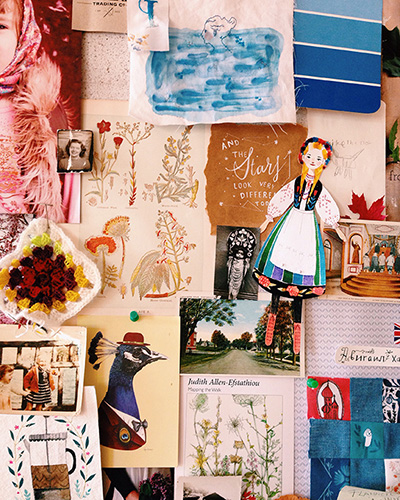
I believe that work which pulls deeply from an illustrator's experiences and emotions has an authenticity that readers respond to. In keeping with that, I mined so many of my own memories and joys while illustrating FINDING WILD (and it's to Megan's credit that her story triggered so many wonderful recollections while reading). I drew scenes inspired by childhood camping trips up in the northern Maine woods and the cacti that grow near family in Texas. The city illustration near the end of the book is inspired by my first trip to New York City and walking the Brooklyn Bridge with my sister.
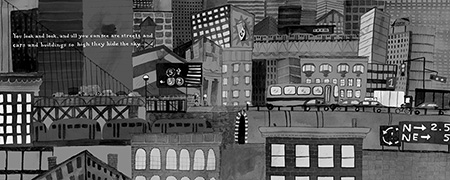

In short, I tried to bring to the artwork the wonder and happiness that nature has brought me, in the many ways I've experienced it.
Watch a video on Abigail's method on YouTube (click the image):


A BIG HEART = AUTHOR SUCCESS
written by Carmen Oliver
illustrations by Jean Claude
Elizabeth talks about “Heart Art,” the part that makes the illustration magical. For a writer. For me, “Heart Art” or “Heart Story” is author intention. My heart is in everything I write. I believe it’s in every author’s work.
Embedded. Woven. Waiting to be discovered.
The real reason behind why the author wrote the book. And when a writer tells a story with their heart stitched into the fabric of a manuscript well, then, success. Magic. Bliss.
Donald Mass in his novel
The Breakout Novelist said, “Success as an author requires…a big heart.” I agree.

I think it takes a big heart to come back to the page, time and time again when things aren’t working. When you’re frustrated. When the doubts creep in. I think a big heart encourages the writer. Trust yourself. Begin again. You can do this. Go on, we’re in this together. A big heart can’t give up. It cares too deeply. About the story. About the characters. But most of all, about the readers. About delivering a story that matters to them. And yes, to you too.
A big heart reaches out and extends a hand to fellow writers. Knowing helping them achieve success is a reward unto its own. By serving them, you receive something too. A big heart knows there’s room for everyone.
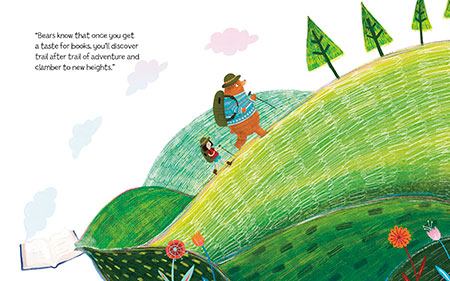
I also believe a successful author is one that measures all the achievements, big or small. A page written today. A chapter finished. A novel outlined. It’s not always a book sold. #1 in sales. An award in your back pocket. Success comes from working day in and day out. Slow and steady. Writing when you don’t want to.
A big heart is open to all possibilities. Knowing that there is more than one way to get to the destination. Knowing that failure is needed to get to success. Knowing that humility and humbleness make us do our jobs better. A big heart knows anything is possible. And we don’t have to step on people to get there.
In my heart, I know there are no coincidences in life.

That if you allow your heart to be open, big and wide, well there’s nothing you can’t do. So let the people in. Learn from whoever is willing to teach you. Love the work. Lift others.
Don’t worry about success. It’ll find you. All you need is a big heart.
If you’re in Austin, TX this summer, Carmen is teaching Perfecting the Picture Book I at The Writing Barn and later this September at Highlights with Don Tate’s workshop The Journey: Your Path to Publication with special guests, Alison Green Myers, and Kathleen Hayes. Carmen's fave writing spot at a lake house...


I've been a fan of Rafael Lopez's work since it came on my radar several years ago, so I'm thrilled to have him on my blog celebrating his new picture book,
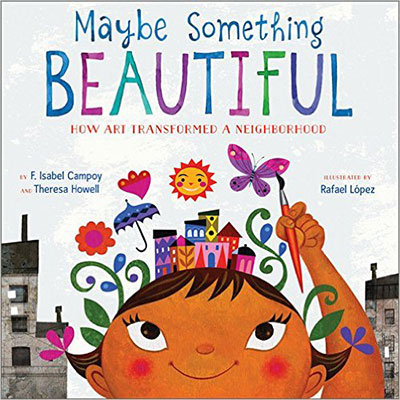 e: What is your creative process, can you walk us through it?Rafael:
e: What is your creative process, can you walk us through it?Rafael:This was the first time I had the opportunity to create a book based on my own experiences as a community muralist. I like to create mood boards where I paste imagery, textures and key words that might fuel the visual storytelling. I rode around on my bicycle and took photographs of neighborhood buildings, printed these out and put them up in my workspace. I sit with the text and begin sketching on tracing tissue, taking a long time trying to channel the spirit of my characters. It’s important to me to show a diverse group of characters because it authentically reflects the neighborhood. I also want children to see themselves on the pages of books I create. I then refine my characters into more finished sketches and begin to develop scenes for the spreads. I print these out into small books to check transitions and see how the visual structure of the story is flowing. I think making children’s books is like making a movie so I want the story to unfold, give it voice, form and viewpoint.
 e: What is your medium?Rafael:
e: What is your medium?Rafael: I really wanted to include the actual buildings from the East Village neighborhood where the story takes place. For this reason, Maybe Something Beautiful is a mixed media book that combines my original photography that was scanned, combined with construction paper and digital textures that I have photographed over many years. Characters were painted with acrylic on wood and for some of the background textures I used watercolor on paper.

 e: What do you think makes an illustration magical, what I call "Heart Art” - the sort that makes a reader want to come back to look again and again? Rafael:
e: What do you think makes an illustration magical, what I call "Heart Art” - the sort that makes a reader want to come back to look again and again? Rafael:The illustration is a door, that readers can unlock and interpret in their own way. I want my children’s book illustrations to be conceptual, a clever interpretation of the text and not see-say where you read and see the same thing. To genuinely connect to readers I want each illustration to stand on it’s own but also work as a whole. There are many tools you can use to create a sense of wonder like color or texture but the idea always rises to the top.
 e: This book is based on a real story - can you share?Rafael:
e: This book is based on a real story - can you share?Rafael:The story is based on the
Urban Art Trail in San Diego, California that was created by my wife and I with the community. We bought an old warehouse in what was an edgy part of town that at the time had issues with crime and blight. We worked with community members to transform the neighborhood using art that included large scale murals, painted electrical boxes, sidewalk poetry, mosaics and sculpture. I developed a style of murals that made it possible for untrained artists and children to achieve a strong result. The collective act of making art brought people together and created a sense of place that improved the community.
(This is Rafael's wife, Candice, painting.)
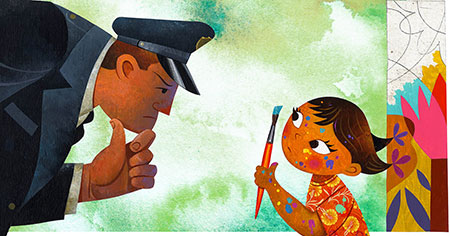 e: What is your favorite or most challenging part of being a creator?Rafael:
e: What is your favorite or most challenging part of being a creator?Rafael:The most challenging part of being a creator is encouraging clients to break away from traditional solutions and try alternative ideas and techniques.
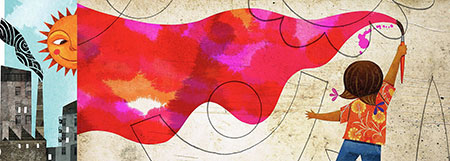 e:
e: 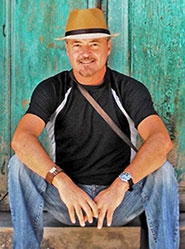 Is there something in particular about this story you hope readers will take away with them, perhaps something that isn’t immediately obvious?Rafael:
Is there something in particular about this story you hope readers will take away with them, perhaps something that isn’t immediately obvious?Rafael:Everyone has unique abilities and ideas. We were originally advised that the best way to deal with crime and blight was to form a Neighborhood Watch. This was a good idea but just one approach. Through this experience I recognized the importance of using my own skills to make a difference. I also connected to others who had their own way of problem solving and brought those strengths to the collective table. I learned so much from them, am still learning and growing.
Here is Rafael's studio - click the image to see it larger in a new window.
 Loved this? CLICK HERE to read Rafael's post about the illustration method he used in MAYBE SOMETHING BEAUTIFUL.
Loved this? CLICK HERE to read Rafael's post about the illustration method he used in MAYBE SOMETHING BEAUTIFUL.
Keith Negley came on my radar with his first book, TOUGH GUYS HAVE FEELINGS TOO. So I'm thrilled to have him on to talk about his method with that and his latest book, MY DAD USED TO BE SO COOL.
 e: What is your medium?
e: What is your medium?
Keith:I’m always changing this up and tend to use whatever works for me in that moment. The end result is typically a combination of charcoal, tempura paint, pencil, cut paper, and then collage and manipulation in photoshop. It all ends up as a digital file when it’s done but has lots of hand made elements.
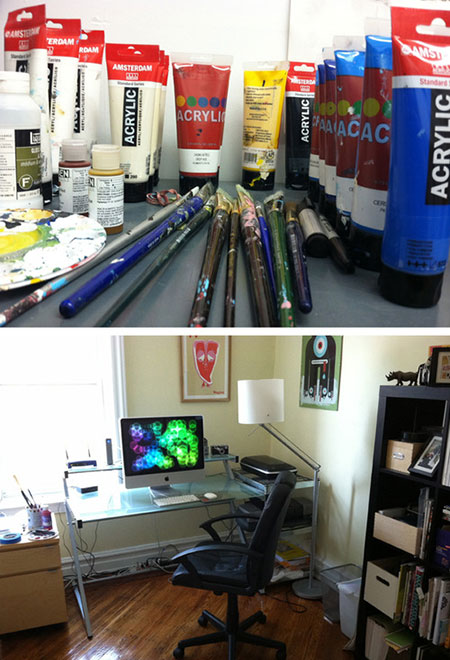
 e: What do you think makes an illustration magical, what I call "Heart Art” - the sort that makes a reader want to come back to look again and again?
e: What do you think makes an illustration magical, what I call "Heart Art” - the sort that makes a reader want to come back to look again and again?
Keith: Heart Art, I like that! I think the viewer needs to see themselves in the piece. It needs to be relatable somehow. When the viewer can see themselves in the art that’s when they can feel empathy for the characters and create an emotional connection. I think how an image makes us feel makes a much longer lasting impression than how impressive the technique is (though technique is extremely important). The best way to create relatable work is to draw what you know, and work from your own personal story. Deep down we’re all dealing with the same joys, and insecurities.
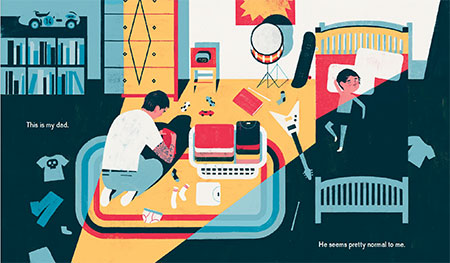 e: Is there a unique or funny story behind the creation of this story?
e: Is there a unique or funny story behind the creation of this story?
Keith:Before I became a dad I played in rock bands and toured the country playing dive bars and house shows. I spent my money on tattoos and vintage scooters and skateboards. Then I became a dad and all that went on the back burner. Now my son is at the age where he’s becoming his own little rebel and really into things like music and motorcycles and skateboarding. For Father’s Day one year my wife got me a reissued vintage skateboard framed in a glass case to hang on my wall. My son saw it and was genuinely confused why I would want a skateboard in a glass frame. To him it was useless if he couldn’t ride it. I tried to explain to him that I used to skateboard a lot and I still love skateboards, but that I don’t ride them any more… and getting to see myself through his eyes was fascinating. To him skateboarding is really cool, and his dad used to do it, but doesn’t anymore and that means his dad used to be really cool. Hanging a skateboard on a wall and not riding is definitely not cool.
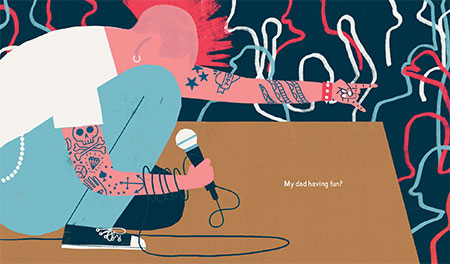 e: What was your path to publication?
e: What was your path to publication?
Keith: I created a rough outline for the book with all the copy and art and sent it to a few publishers I knew. It’s not your traditional children’s book and I knew it might be difficult to sell it to publishers, but Flying Eye saw my vision for what it was and didn’t want to change it, so I was grateful to jump on board with them.

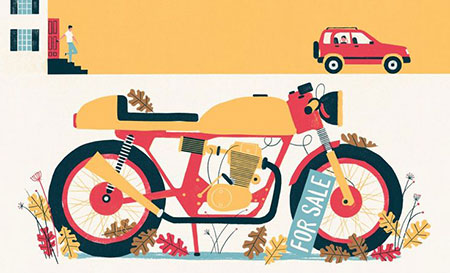 e: What is your favorite or most challenging part of being a creator?
e: What is your favorite or most challenging part of being a creator?
Keith:Balancing life with work. Making a book takes an incredible amount of time and effort and writing in particular is time consuming even though when you’re doing it it doesn’t actually look like you’re doing anything. So it’s very hard to explain to my wife and son that I can’t hang out with them night after night because I’d rather sit in front my computer and stare at it. Creating something from nothing is my passion, I think I would shrivel up and die if I couldn’t create, whether that’s a kid’s book, a painting or a song. It’s almost not like work because I get so much pleasure out of it, but it can also be like heroin in the sense that I can loose track of everything else that’s important to me, including the people who are closest in my life. I have to be very careful not to lose site of what’s most important, my family… and that means putting projects down and taking breaks even when I don’t want to.
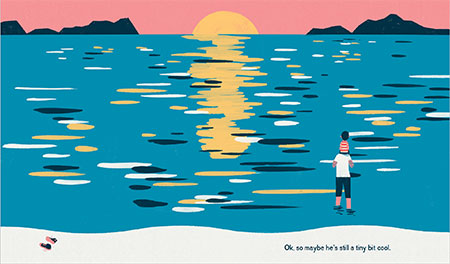 e:
e: Is there something in particular about this story you hope readers will take away with them, perhaps something that isn’t immediately obvious?
Is there something in particular about this story you hope readers will take away with them, perhaps something that isn’t immediately obvious?
Keith:Truth be told this book is just as much for dads as it is for kids. I want parents and dad’s especially to feel acknowledged for the sacrifices they made to be awesome parents. People think when you become a parent your priorities shift overnight, and maybe that’s true for some, but there are others who, while willingly, struggle to give up large parts of their identity in order to be the best parents they can… and that’s not easy. I wanted to make a book that gave a nod to those parents, and also had fun with the situation as well.
 e:
e: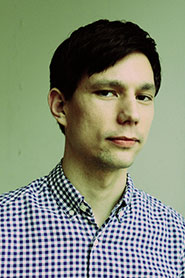 What are you working on next or what would be your dream project?
What are you working on next or what would be your dream project?
Keith:I’m going to start working on my third book that’s going to be a little different from the first two, I don’t want to give anything away but I’m really excited about it. It will be a kind of picture book that doesn’t really exist yet but desperately needs to. Wish me luck!
Good luck, Keith! And thanks for stopping by! 


Ursa’s Light
by Deborah Marcero PART 1: PATH TO PUBLICATION I have always loved writing and drawing. My love of making art took me to art school, then to New York City for a few years, which then led to me to an MFA in Poetry.
In all those years of my twenties I collected many tools, but even after my MFA, I still wasn’t sure how I was going to use all that I had learned to build a creative life. After a few years of freelancing, I decided to take another turn altogether and dedicated myself to teaching.
I worked in the Chicago Public Schools as a reading and writing lead teacher for three years. This job, with all its rewards and hardships, gave me an incredible gift: it re-introduced me to the books I fell in love with as a kid, and showed me NEW books I wished were around when I had been in fifth grade.
I led enrichment programs, one of which was “Young Authors," where I stayed after school and helped my students publish their works as authors and illustrators. Working with them, made me realize, I want to do this. For real. That was 2009.
In between then and now, I stopped teaching, started my own photography business, moved to a small city in Michigan and began to dedicate half or more of my time to writing and illustrating. In Ursa’s Light, my debut picture book, so much of my journey to publication is in her story. Ursa is a dreamer and a scientist. She embodies one of my favorite quotes from Thoreau:
“If you have built castles in the air, your work need not be lost; that is where they should be. Now put the foundations under them.”
It is through being a dreamer and a pragmatist, that I found my path. And like Ursa, I have failed many times. Each of those failures shaped my journey and forced me to be even more determined, creative and patient.
Ursa’s victory isn’t just that she becomes a shooting star in the play. It’s more than that. Her dream, her amplified study of the world, her taking risks and making embarrassing mistakes and ultimately being brave enough to be HERSELF in front of everyone - is her shining moment. To be her true self, to be seen, to be vulnerable – flaws, oddities and all – to follow the beat of her own drum, to forge her own path is Ursa’s journey, and it’s mine too.
I am now writing and drawing every day. I wake up every morning to a life I am truly grateful for. I am still failing and learning and growing. But all those tools I’ve picked up along the way, from 1000 hours of figure drawing in art school to studying poetry, to teaching narrative writing to my fourth graders – all those tools are on my table now. They are in use, and helping me build the creative life I have always wanted.
PART 2 : ILLUSTRATION METHOD FOR URSA’S LIGHT Once the manuscript was approved, I composed and paced all the spreads in detail with a very fine pencil (2H 0.3 mm lead).

Once the sketches were approved, I inked in all the lines with Black Cat India ink and a dip-ink pen.
Then, before I moved to color, I decided on a color palette for the entire book (this is the MOST important part!). I was also given the option to create a font for Ursa (which, consequently is one of my favorite things to do) so of course, I said YES.

Ursa’s palettes of rusts, mossy greens, sometimes-heavy blacks, brick red and navy anchor the story in a gritty pull-yourself-up-with-your-own-bootstraps kind of tone, and avoids (for example) saccharine pastels, which could have turned Ursa’s tale into something different altogether. Not that I don’t love pastels – I DO! Just not for Ursa.
After I established the palette, I created a stack of potential textures – woodblock cuts, ink lines, watercolor, gouache, etc. on my drawing table. Then, finally, I digitally layered, pieced and collaged them into the ink line-work.


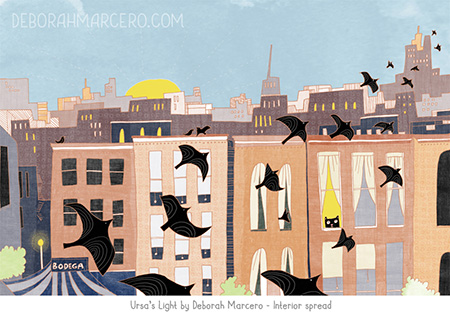
A little more behind the scenes development of my illustration style for Ursa’s Light can be found on my blog here:
http://deborahmarcero.com/coming-soon-ursas-light/.
Website:
deborahmarcero.comTwitter:
@deborahmarcero


Writing A Bandit’s Tale
by Deborah Hopkinson My new historical fiction middle grade novel,
A Bandit’s Tale, The Muddled Misadventures of Pickpocket, is set in 19th century New York City. Although the book deals with some serious themes, including poverty, child labor, and animal rights, I didn’t want the story to be depressing. So I decided to write the story as a rather light-hearted picaresque novel.
I’d never tried anything like it before, and I had so much fun doing it. As I researched the genre, I learned that the word “picaresque” comes from the Spanish “picaro,” which means “rogue” in English. The first picaresque novels were published around 1600 in Spain. One common characteristic of picaresque novels is that the protagonist is not well-born or aristocratic. Instead, like Rocco in
A Bandit’s Tale, the hero is a poor individual forced at a young age to live by his or her wits in a hostile society. The story is often told in first person and has an episodic plot structure, as we follow our rogue from misadventure to misadventure.
One of the masters of the comic picaresque novel was Henry Fielding, who wrote
The History of Tom Jones, a Foundling (1749) and
Joseph Andrews, or the
History of the Adventures of Joseph Andrews and his Friend Mr. Abraham Adams (1742). When I was writing
Bandit, I often turned to the online versions of these books (available through the Gutenberg Project) for inspiration, and the chapter headings definitely reflect Fielding’s style. My favorite one is chapter nineteen, which takes place during the famous Blizzard of 1888: “Containing a storm so terrible that the reader cannot laugh even once through the entire chapter.” And it is a terrible storm, indeed.
In addition to having fun with history in the storytelling, I definitely wanted to provide factual background information. When I read historical fiction, I’m always curious to know what’s real and what’s invented. And though I’m sure not all young readers will take the time to peruse the Author’s Note (which is entitled “Containing a variety of facts and resources of possible interest to the reader, as well as information illuminating historical personages”), they might, perhaps, be interested in the 19th century pickpocket slang.
Since I visit schools all over the country, I’m always attentive to how books can complement curriculum or enhance STEM connections. Social reformer Jacob Riis appears as a character in
A Bandit’s Tale. His arresting photographs brought attention to the deplorable living conditions for children and families in the tenements of the Lower East Side. Yet those photographs were only possible because of the invention of flash photography, which allowed the self-taught photojournalist to bring these problems to light. In
A Bandit’s Tale, we have included several Riis photographs, which I hope will help illuminate the time period and setting for young readers.
When I speak in schools, students often ask if I plan to write a fantasy novel someday. The truth is, when I write about history I am always learning, and I can’t think of anything more exciting or rewarding. I hope that young readers will take a chance on historical fiction and nonfiction, and can’t wait to share
A Bandit’s Tale with them.
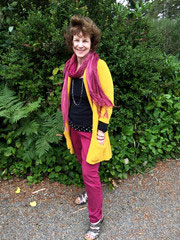
Award-winning master of historical fiction for children Deborah Hopkinson takes readers back to nineteenth-century New York City in her new middle-grade novel: A BANDIT’S TALE: THE MUDDLED MISADVENTURES OF A PICKPOCKET (Alfred A. Knopf Books for Young Readers | on sale April 5, 2016 | Ages 8–12 | $16.99).
“A strong chose for those who enjoy adventures about scrappy and resourceful kids.” —School Library Journal, Starred Review
“A dynamic historical novel ideal for both classroom studies and pleasure reading.” —Publishers Weekly, Starred Review

Thanks again to Deborah Hopkinson for appearing. For other stops on the Bandit Blog Tour please check deborahhopkinson.com. Be sure to use this hashtag: #BanditBlogTour.
P.S. - Here is Deborah's Office Assistant, Rue, and Rue hard at work.
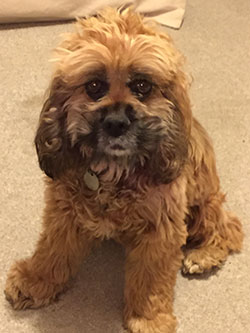
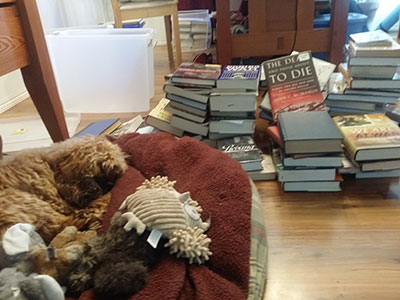

I am thrilled, thrilled, thrilled beyond belief to have the creators of THE SECRET SUBWAY on dulemba.com today! I was first turned on to the topic of a pneumatic subway in New York City when Elon Musk (inventor of Twitter) brought up the idea for California. Articles started popping up about the history of such subways in other cities around the world, including New York City, right in the middle of the corrupt Boss Tweed era. Gads, I was hooked!
Along came Shana Corey, Red Nose Studio - one of my favorite illustrators, editor Anne Schwartz of Schwartz and Wade Books (RH), and WOW. This book is Stunning, Fabulous, Interesting... I can't give you enough adjectives!
Lucky us, Shana and Chris (a.k.a. Red Nose) have stopped by to let us eaves drop on a creative conversation about the making of this fantastic picture book. Take it away guys!
 Shana:
Shana:Thank you so much for having us Elizabeth!
The Secret Subway, just came out and Red Nose Studio and I are excited to share a peek at the process behind it with you. You can also see the trailer here (click the image to watch in a new window on Youtube):
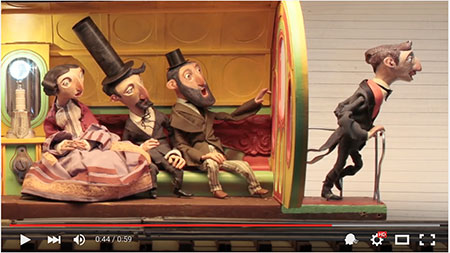
I first came across a mention of Alfred Ely Beach-the editor of
Scientific American and the changemaker behind NYC's first subway-a block long pneumatic tube he built in 1870 without official permission--when I used to visit the
New York Transit Museum with my kids. I initially didn't focus on Beach but wrote a version that was an overview of the entire NYC subway history and that focused much more on building our current system-but I was so intrigued by Beach I wrote a second version that focused entirely on his story, and that's the story I sent to Anne Schwartz at Schwartz and Wade. I have always loved the books Anne edits and was incredibly excited and honored when she took on The Secret Subway.
Anne shared it with
Red Nose Studio, and I was blown away by the art he created-he took it to a whole new level. So for this post, I thought I'd ask Chris Sickles (aka Red Nose Studio) some of the questions I've been curious about.
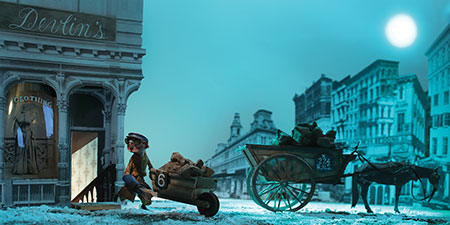
(Click the image to view a larger version in a new window.)Shana: Chris, for the art you create 3 dimensional scenes and then photograph them. Do the scenes always follow the sketches you create or do you rearrange them when needed as you go? And do you ever create pieces you don't end up using in the final?

(Click the image to view a larger version in a new window.)Chris: Most everything in my illustrations are built by hand, so I always aim to only build what gets seen. Some images get revised or changed in order to accommodate an edit in the text or the layout, but generally the finals are built to match the sketches which are like an architects blueprints.
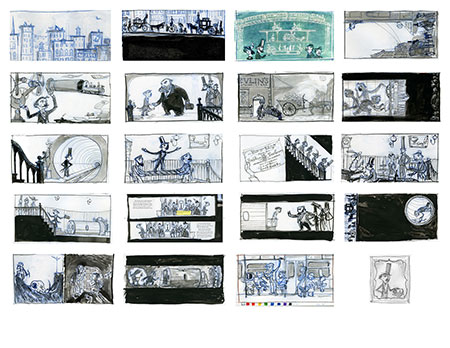
(Click the image to view a larger version in a new window.)Shana: Did you have rough versions of the Beach puppet you created before you settled on the final?
Chris: I sketched roughly 20 versions of Beach trying to get a character drawing that I felt caught the essence of who he was. Once that was established I then moved forward with sketching out the book. While sketching the book Beach became a little more refined as I drew him from different angles and with different expressions. Only after the book dummy was approved did I start sculpting Beach.

(Click the image to view a larger version in a new window.) Shana: How many different expressions did you create for Beach and how did you determine how many to do?
Chris: After the dummy roughs of the book where revised, refined and approved I could look through the pages and see that Beach roughly had five expressions throughout the book. He was excited/happy, relaxed, determined, flabbergasted, and defeated. From those moods, I was able to sculpt five separate heads which could be swapped out depending on the image I was shooting at any given time.
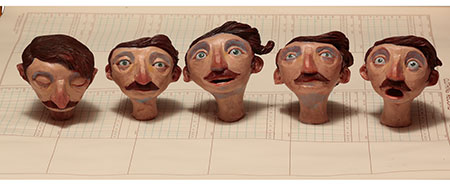
(Click the image to view a larger version in a new window.)Shana: What do you do with the pieces when the book is finished?
Chris: Most of the environmental elements (skies, grounds, buildings) get filed so that they can be reused on future projects. The various props get stored as well for future use. The characters/puppets get placed upon shelves and kept together for exhibits and Beach himself travels with me to book events and school talks about the book.
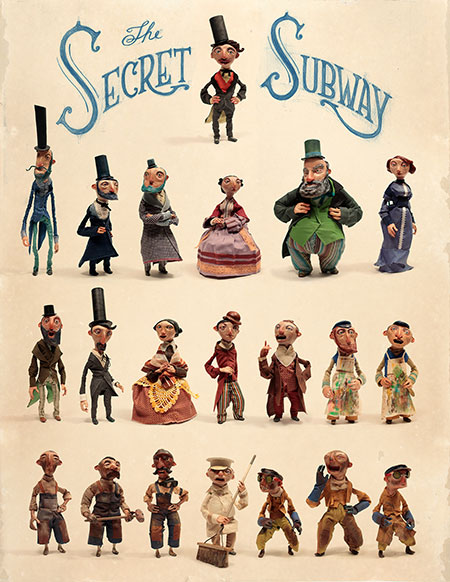
(Click the image to view a larger version in a new window.)Shana: Thank you Chris! And thank you again for having us Elizabeth. You can find reviews and other extras (including printables) for the Secret Subway on our websites,
www.shanacorey.com and
http://www.rednosestudio.com/blog.htm. And for your NYC readers, Red Nose Studio has a new poster that's in the subways right now as part of the MTA's Arts & Design Project-so next time you're on the subway you might just be riding with Beach and his subway!
e: THANK YOU BOTH!

Today I am thrilled to have
Francesca Sanna visit to talk about her debut picture book, THE JOURNEY. And what a debut it is! It's a refugee family's journey from war and loss, and it could be taking place anywhere in the world and at nearly any time. Even though it is especially timely now. It's a book that will grab you and never let you forget...
e: What is your medium?Francesca: I work with mix media, I usually start with sketching and doing my textures with pencils and inks, and then I move to a digital support and I develop the final artwork.
 e: What do you think makes an illustration magical, what I call "Heart Art” - the sort that makes a reader want to come back to look again and again?Francesca:
e: What do you think makes an illustration magical, what I call "Heart Art” - the sort that makes a reader want to come back to look again and again?Francesca: In my opinion it is "that something" that leaves a space for the person that look at the picture to fill with his own experience or emotions. When a picture leaves a small part of the story open, this makes you want to watch it over and over, trying to complete it.
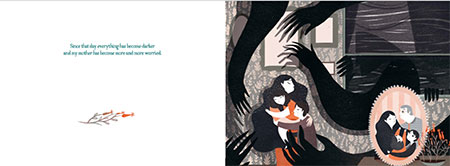
Click the image to view larger in a new window.e: Is there a unique or funny history behind the creation of this story?Francesca: This is a very important question for this book, because it is in fact a collection of stories and experiences. I interviewed a lot of people before I started creating this story, and they came from many different countries and cultural backgrounds. One time in particular, I was interviewing a young guy from Tibet, but we could not find a way to communicate (he did not speak English but only German, and my German was, and still is, pretty bad!) and after a few attempts we found that the situation was stuck: we really could not understand each other. So we ended up drawing, me to ask him the questions, and him to answer them. It has been an intense and at the same time also funny experience, and since that time I discovered that sketching is a very good way to overcome language barriers!
e: What was your path to publication? Francesca: I developed my book project at the Master of Arts I finished almost a year ago in Lucerne, Switzerland. Once I had finished with my studies I sent a description of the project to Flying Eye Books. About a month later we started working together on what now is the final version of "The Journey".
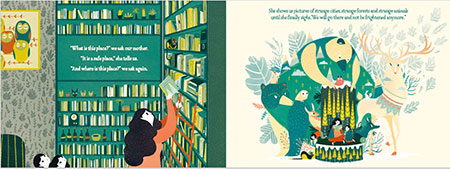
Click the image to view larger in a new window.e: What is your favorite or most challenging part of being a creator?Francesca: My favorite part is when you are completely absorbed in your project and it flows one step after the other. I think the most challenging parts are the beginning, when it is only you and the white paper, and the end, when you can't sleep at night thinking "did I forget anything? Is this project really done?"
e: How do your creations invade your reality?Francesca: Physically: on every small piece of paper around my apartment or my studio, every shopping list or memo note is full of small sketches. In a less material way: it is very hard for me, if I have a project or an idea I want to develop, to not use every single free moment I have to think about it. For this reason sometimes it gets hard to switch off the brain, even when it would be useful to take a break from work!
e: Is there something in particular about this story you hope readers will take away with them, perhaps something that isn’t immediately obvious?Francesca: It is always a difficult exercise to empathise with a situation that seems very far away from ours. I would like this book to fill the gap between us and "the others", and really make a reader think "this could have been me" or "what would I do in a similar situation?"
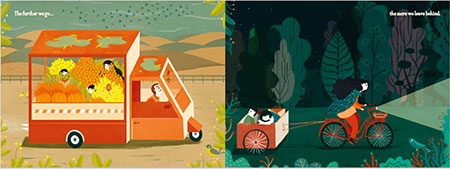
Click the image to view larger in a new window.e: What are you working on next or what would be your dream project?Francesca: I am at the moment experimenting with new ideas and topics, and I am in that phase where I am not completely sure about what direction the next work will take.
One of my dream projects (I definitely have more than one!) would be to work on the theme of gender equality. I am Italian and in my home country there has been a lot of discussions lately whether this topic should be the center of a children's book and children's literature or not. I personally think it is very important to talk with children about this issue and I would really like to start a visual research about it.
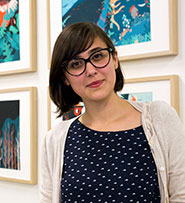 Bio:
Bio:
Francesca is an Italian illustrator and graphic designer based in Switzerland. After she finished her studies in Cagliari, the main city of her beloved Mediterranean island (Sardinia) she said goodbye to her family and her cat (Berta) and moved to Germany before and Switzerland after, in order to follow her dream and be able to work as illustrator. She graduated with honors in 2015 the Lucerne School of Art and Design, with a Master of Design with focus on Illustration. Learn more at www.francescasanna.com.

Making Real Look Real -
- The Material Challenges of Three Dimensional Illustration
by Rebecca Dudley Just last week I was wracking my brain, trying to think of a modeling material that had some mass to it, something like clay, but flexible and light. I tried metal mesh but it is awful -- the edges are sharp, it was like trying to make origami with a ball of pins. Chicken wire has the same problem, and it fights your efforts to make mounds with it, it wants to be flat. I returned to my old standby, clay, but making masses with clay is not ideal because it is expensive, takes a long time to dry and solid clay can be quite heavy, even when completely dry. I was staring at a heap of mangled wire mesh I realized I had something in the kitchen that was better than all these materials: aluminum foil. It is light, inexpensive, abundant, it can be stretched, squeezed and punctured. I have been using it for a week now and it is my new favorite material!
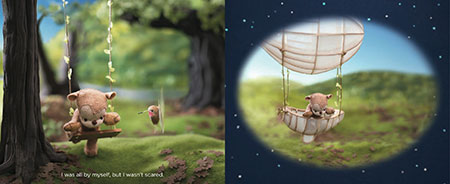
Click the image above to see a larger version in a new window. All the materials I work with are easily available – everything in my pictures is clay, wire, cloth, wood or paper. I built Hank’s little blimp from bass wood. I drew the frame directly on the bass wood sheets, cut it out and covered it with ‘silkspan’, a paper that tightens a little bit when spritzed lightly with water. It is an old technique, the same technique my father used for making model planes in the 1930s. It takes patience, and just a little skill.
For everything that appears in my scenes, every tree, stream, stone, leaf, and character, there are dozens of failed prototypes. I make things that look good by first making a lot of things that look bad. I experiment a lot with materials, which means there is going to be some waste. I can usually find a use for the rejected prototypes. I have a big bag of dried clay which works great as “landfill” when I am building mountains.

Click the image above to see a larger version in a new window. The trees are made from lightweight, air-drying clay. I made so many awful trees before I came up with the technique I use now. After dozens of attempts to make clay look like bark it occurred to me that bark is a record of movement and, specifically, a record of stretching. I realized I needed to make the tree bark using a method of stretching, so I found stretchy clay and it worked really well. All previous clay bark attempts showed my finger marks which gave away the scale of the model trees and ruined the illusion that the whole set is larger than it really is.
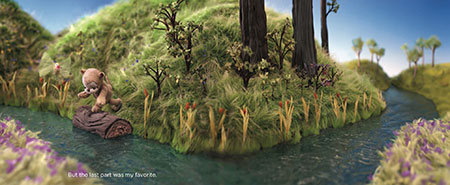
Click the image above to see a larger version in a new window. Hank is sewn from three different fabrics. It took about a month to make him. I made four prototypes before I made the Hank you see in the books. Hank has a “stand in” or understudy so he doesn’t have to spend the entire day on set. I use the understudy for scale. As I am building a set I need to see where Hank is going to be in the final image. I may change an entire set if Hank’s head is not hitting the horizon line the way I want it to, so I need a version of Hank on the set constantly as I am building the scene.
I use Photoshop to remove the little supports that hold everything in place, pins and wires, but I try not to use it for anything more than that. It would be easy to add dramatic light and shadows in Photoshop, but when I am tempted to tweak the overall image that way I know it is a sign that the picture is not good enough and I need to re-take it. Children are exposed to so many Photoshopped images and I want them to be able to look at my photographs and trust that the scenes are real.

Click the image above to see a larger version in a new window.Click the image below to watch the book trailer for HANK HAS A DREAM on YouTube - FABULOUS!
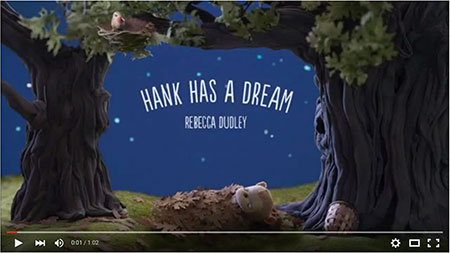


Story Behind the Story
by Jaleigh Johnson The story behind THE SECRETS OF SOLACE is as simple as this: I love museums. I always have. To me, they are windows to times and places that are gone now, attempts at preserving things that need to be remembered. Several years ago, I visited the Louvre in Paris, France. What a fascinating place. You step into a big glass pyramid, walk down a turning stairway, and there you are, with paths to cavernous, connected rooms and thousands of artifacts waiting to be explored.
As I walked through each room, night began to fall, and the windows turned dark. The museum was open later than usual that night, and as the crowds began to thin and my footsteps echoed on the floors, I began to feel as if I was in a different world. I could have explored for ages.
My mind always being in one world or another, after that visit I began to think about the idea of a museum filled with objects preserved from different worlds. Who would build such a place and why? That’s how I came up with the idea for the archivists, the dedicated men and women who have made it their life’s mission to study and preserve the objects from other worlds that fall in the meteor storms in Solace. They collect objects and store them in vast, underground museums deep in the mountains. Some of these objects are beautiful, some scientific, and some of them feel like magic. All of them are worthy of being preserved and remembered, but in such a large museum, sometimes things get…lost.
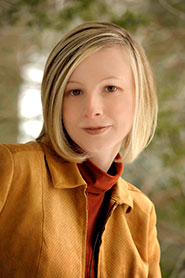
It’s up to my protagonist, Lina Winterbock, a lost girl herself, to find them. She teams up with a brave, resourceful boy named Ozben, and their adventures and choices could end up changing their world forever. Because every object, no matter how small, has a purpose, and every person, no matter how small they may feel, is important.
Bio:
JALEIGH JOHNSON is a lifelong reader, gamer, and moviegoer. She loves nothing better than to escape into fictional worlds and take part in fantastic adventures. She lives and writes in the wilds of the Midwest, but you can visit her online at jaleighjohnson.com or on Twitter at @JaleighJohnson.

This week I'm starting a new feature I'm calling HEART ART. These posts will be about books, new and perhaps a little older, that are illustrated with such skill and magic, they capture the reader and won't let go. Sometimes I'll get interviews with the illustrators, sometimes not, but I won't let that stop me from sharing some exceptionally illustrated books with you! So be looking for my new logo on books I think are extra special and full of true HEART ART!
I'll begin my HEART ART feature with...

Just in time for Easter, although it a lovely story at any time of the year, a special anniversary gift edition of Guess How Much I Love You is now available with a gold cover and a unique note from the award-winning creators inside. Sometimes, when you love someone very, very much, you want to find a way of describing how much you treasure them. But, as Little Nutbrown Hare and Big Nutbrown Hare discover, love is not always an easy thing to measure! Now new and existing fans can relive this cherished classic with this lavish edition, celebrating two decades of delighting readers since its initial creation.
Go to
www.guesshowmuchiloveyou.com to learn more about the book and download free activity pages!
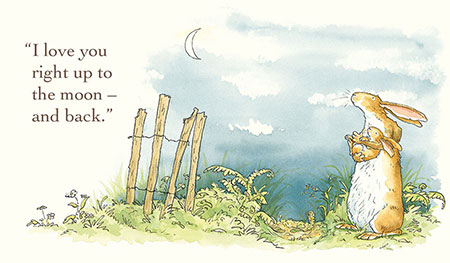
 So what makes Guess How Much I Love You HEART ART? Look at the interactions between the characters, the sense of play, the wonderful gestures. Also notice the fine ink line and delicate watercolor. There's a reason this book has become a classic!
So what makes Guess How Much I Love You HEART ART? Look at the interactions between the characters, the sense of play, the wonderful gestures. Also notice the fine ink line and delicate watercolor. There's a reason this book has become a classic!

THE BUNNY BURROW BUYERS BOOK
by Steve Light This book started with a brush stroke. I had been studying Zen paintings and doing some large drawings that had a large brush stroke as the main design element. So when Sharyn Rosart, my editor at Powerhouse Books, asked me for book ideas I just showed her a page of brushstrokes with red dots! Being the super editor that she is, she said, “Great! How can we make it a book?” I did not know what the red dots would be but knew I wanted a single brushstroke to run through the whole book.

At first, the red dots were going to be a ball bouncing through the country side. Then I remembered an idea I started in another sketchbook about critter real estate and the animals in the forest selling their nests, burrows and caves. Then it hit me, the red dots could be the holes to burrows and it could be about one bunny family looking for a new burrow.
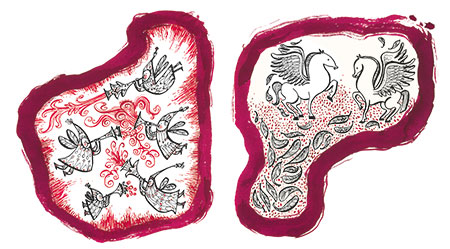
All the artwork was produced on one long accordion folded piece of paper about 6 feet long! It was exciting and fun making that great long brushstroke. The brush I used was made of rooster feathers and gives a very scraggily line. Once the brushstroke was painted and the burrow holes were placed I started drawing all the trees and bunnies. The red dots became die-cuts so children could place their little fingers through the holes like little bunnies.
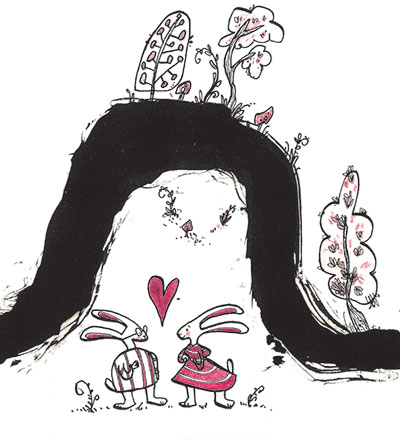
Instead of an accordion fold book, which became too difficult to read, the pages have gatefolds allowing the reader to see inside each burrow.
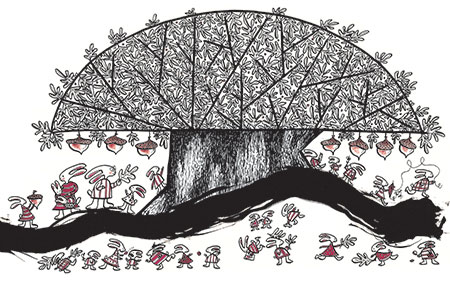
I kept the color scheme simple in black and red so the burrow holes would still be the red dots on the brushstroke. The end pages are the classifieds from a newspaper, listing different burrows and critter homes for sale. Some of the listings are for famous bunny homes but I’ll leave that to the reader to guess who they are.
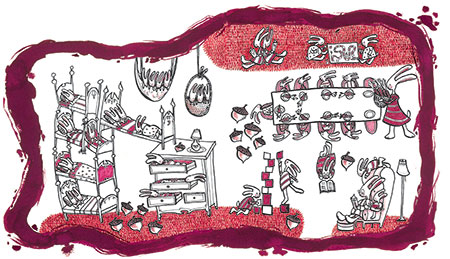
The fact that on every page turn the bunny family would get bigger, making them look for a larger and larger burrow, delighted me. I also had fun making the burrows occupied by ogres and dragons and fairies. This just added a more magical and a little bit scary element to the book.
Moving can be a scary time for kids but hopefully they will come to realize that as long as their family is together, then they are home.
The brush stroke becomes the ground that the trees and burrows are growing out of, like a safety line connecting the old burrow home to the new one. All the places you live become apart of you, just like your family. So that is how I came to make a bunny brushstroke book, The Bunny Burrow Buyers Book, A Tale of Rabbit Real Estate and my longest book title ever!
 Bio:
Bio:
Steve Light is the author of many best-selling children's books, including the Vehicles Go! series (Trucks Go!, Trains Go!, Diggers Go!, Planes Go! and Boats Go!, all from Chronicle) and Have You Seen My Dragon? (Candlewick, 2014) Steve is a preschool teacher and professional storyteller who lives with his wife in New York City. Learn more at http://stevelightart.com Click the image to watch Steve in his studio at
All the Wonders.


Today I have the honor of featuring a fellow Erin Murphy Literary Agency creator,
Shennen Bersani. She's stopped by to tell us about her new book, ONCE UPON AN ELEPHANT written by Linda Stanek.
e: What is your creative process, can you walk us through it?Shennen: The very first thing I do with any new book, whether I'm the author/illustrator, or illustrator, is "hands on" research. I want to experience what I'm about to create, I feel this brings an extra level of reality to my work. I've traveled all corners of the country visiting creatures in their habitats. I swam with Florida manatees, crawled in Carlsbad Cavern, held: bats, snakes, jellyfish, squid, spotted salamanders, seals, turtles, frogs, sea slugs, octopus, lobsters, fish of all description, insects of every kind, birds, and more I'm probably forgetting.
From there the creation begins.
I spend countless hours "painting" pictures in my head. While I'm cleaning, driving, catching up on my to-do list, my mind is running though an illustration or piece of art - step by step. By the time I sit down to work I have every stroke and color mapped out ready to execute. Before I begin I will clear out the day's stresses; tend to my plants, meditate on who and what I am grateful for, drink six cups of coffee…. kidding, well not really kidding, five cups minimum. (After a few hours of work I move to mugs of tea. My creative process involves a lot of caffeine.) I also love listening to something while I'm working, usually audio books. Any genre! I've just started illustrating my 26th book, so over the years I've listened to every topic under the sun! It all fuels my creative energy.
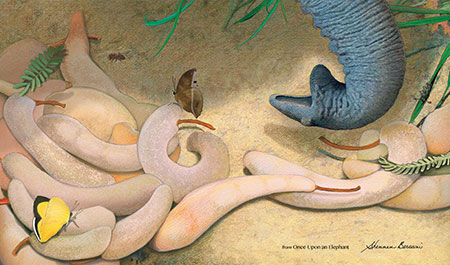 e: What is your medium?Shennen:
e: What is your medium?Shennen: My usual "go-to" medium has been colored pencils on Arches. I scan this art and create a digital file to send to the publisher. Each book has its own voice, with some books I stop there. With others such as,
Achoo! Why Pollen Counts, I added a coating of pollen covering the characters in Photoshop. When using Photoshop I have a Cintiq monitor I draw on. I would have to say though, that over time I am going more digital and I love having a variety of tools to choose from.
The Shape Family Babies (written by Kristin Haas) was illustrated only using Photoshop. The fire scenes in
Once Upon an Elephant (written by Linda Stanek) were created digitally. It is nice not being constrained by one medium.
e: Is there a unique or funny story behind the creation of this story?Shennen: My most recent release,
Once Upon an Elephant, came about after I illustrated
Animal Partners (written by Scotti Cohn). My editor and I got together at the NSTA Conference in Boston to be on a panel discussing researching non-fiction books. While in Boston she mentioned the elephant book, and how it would work well with
Animal Partners. I loved the idea, I had secretly been hoping for an African safari type book to come my way! I didn't get a chance to visit Africa for my research, but I did go to see three very lovely African girls (elephants) at the Roger Williams Park Zoo in Providence, RI.
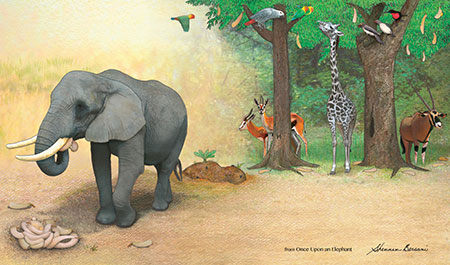 e: What was your path to publication?Shennen:
e: What was your path to publication?Shennen: My first paid illustration assignment was in the Boston Sunday Globe Magazine back while I was still in art school... It was many years down the road, and thousands of illustrations later, when I got into illustrating trade books. I had illustrated many book and magazine covers, articles, numerous educational assignments, and corporate stuff, and on and on. I had shown my portfolio at the Boston Graphic Artists Guild's (GAG) See Party. Each year I passed out post cards to art buyers and I received plenty of work. So when the NYC GAG had their version of the "see party" I figured I would go BIG for their event! I had tri-fold brochures printed showing many images of my published work. I went off to NYC with these colorful promotional pieces, happy as could be... only to be crushed when no art director took them!
The box of unused brochures sat in my basement. It caused me sadness to look upon it. I shoved the box further and further into the cobwebs until it was out of sight. Years passed by. When the spring of 2002 came along I found myself illustrating
Androcles and the Lion, a second grade reader for McGraw Hill. One day I picked up my son from the commuter rail. He was attending Boston College High School in the city and took the rail home each day. He was studying Ancient Greek and Latin, he was the perfect model for Androcles! Ryan hopped into the car all excited saying, "Mom, MOM, I got you a job today!!!” I said something flip like, "Oh what, they need a cafeteria worker at BC High? Or maybe a gardener?"
"MOM, MMOOOMMM YOU'RE NOT LISTENING," Ryan belched. He handed me a baseball card with author Jerry Pallotta on it. I looked at it and instantly commented we had some of his alphabet books, that he was famous... how could Ryan have met him?
Ryan recalled how Jerry was an alumni and how he had gone to the school that day to discuss his writing career with the students. Jerry had mentioned he was interested in an illustrator who could draw a lion. So Ryan simply raised his hand and asked how he hired his illustrators. "Oh, why kid, you know someone who can draw a lion? Let me know."
Unbeknownst to me Ryan was super proud of his "famous" mother. Months earlier he had taken those discarded tri-colored brochures and used them as bookmarks in his textbooks. After Jerry finished speaking to the group of boys, Ryan went up to him, handing him a brochure he said, "You should hire my mother. She is perfect for your books!" Jerry then (surprised? shocked?) asked if I was busy, which Ryan replied, "Not after she finishes Androcles and the LION".
Two weeks later I was assigned Jerry's,
Icky Bug Shapes, published by Scholastic. I haven't had a moments break since. Today I am illustrating a new alphabet book for Jerry, and a Hawaiian seal book for Arbordale.
e: LOVE IT!! e: What is your favorite or most challenging part of being a creator? Shennen: My most challenging part is wearing multiple hats. As an author I want to spend my time out in the public promoting my book. I love sharing it with school kids! But, as a creator who makes her income from illustrating books, I need to be hunkered in my studio for weeks on end alone illustrating. It's very challenging balancing both.
e: How do your creations invade your reality?Shennen: In a literal sense, I've taken up all the spare space in two houses, filling them with rooms of framed art, floor to ceiling stacks of boxes of my books, and art supplies. On a spiritual level I end up imagining what the characters I've created are doing, how would they respond to a situation. I jot these thoughts down, with hopes of writing new manuscripts.
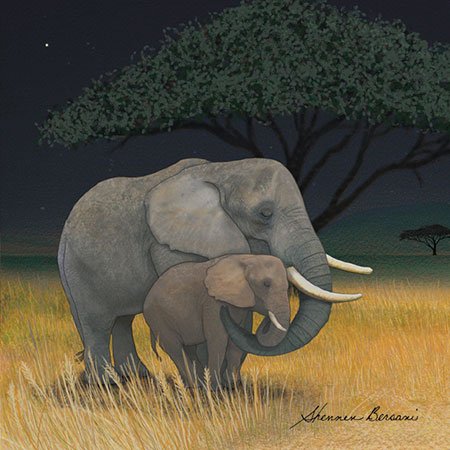 e: Is there something in particular about this story you hope readers will take away with them, perhaps something that isn’t immediately obvious? Shennen:
e: Is there something in particular about this story you hope readers will take away with them, perhaps something that isn’t immediately obvious? Shennen: The book's message is pretty straight forward, elephants are important for the African landscape - from providing water pools for tiny insects - to creating large swaths of trails to break fires. My hope is that the book, and my illustrations, will ignite a child's interest in pachyderms and get kids excited to research more about the creatures.
e: What are you working on next or what would be your dream project? Shennen: Wow, what I'm working on next IS my dream project! Research for my newest book just brought me to Hawaii, where I spent long days in the surf, in search of wild seals. It was a totally amazing experience leaving cold, snowy Boston in the morning, and arriving to walls of sunny blossoming flowers in the afternoon. This trip, I made it over to the Kilauea Volcano - something I have always dreamt of experiencing. But that didn't come close to being off the beaten path and walking on lava among monk seals and sea turtles basking in the sunshine. Paradise.
e: Congratulations!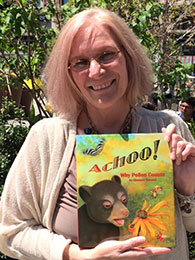 Bio:
Bio:Shennen Bersani is an award-winning children’s book illustrator with 2 million copies of her books cherished and read by children, parents, and teachers throughout the world. Her art delivers a unique blend of realism, heartfelt emotion, love of nature, and life lessons for children of all ages. She has illustrated Once Upon an Elephant, Salamander Season; Sea Slime: It’s Eeuwy, Gooey and Under the Sea; The Shape Family Babies; Animal Partners; Shark Baby; Home in the Cave; The Glaciers are Melting!; and Astro: The Steller Sea Lion for Arbordale. In 2015, Shennen made her debut as an author with Achoo! Why Pollen Counts. Shennen lives with her family near Boston. For more information, visit her website at
www.shennenbersani.com.

Sean Taylor is the author of many books for young readers. He has published middle grade and teenage fiction, but he is best known for picture books such as WHEN A MONSTER IS BORN, CROCODILES ARE THE BEST ANIMALS OF ALL, ROBOT RUMPUS! And IT’S A GROOVY WORLD, ALFREDO!. Here he talks about HOOT OWL, MASTER OF DISGUISE (illustrated by Jean Jullien), which has been shortlisted for the 2016 ‘Lollies’ Best Laugh Out Loud Picture Book Award. It comes out in paperback on 3rd March this year.
 E: What is your creative process, can you walk us through it?
E: What is your creative process, can you walk us through it?Sean: Any ability I have to write picture book stories probably owes a good bit to an apprenticeship in poetry. I wrote poems seriously (sometimes comically) for many years. This included a good bit of performance poetry. And my first book was a collection of poems for adults. Writing poetry taught me to work at language until it is, as Samuel Taylor Coleridge put it, “the best words in the best order.” (Or as near to that as I can manage…)
I was doing this yesterday. I scribbled out the first 300 words of a new picture book story. Then I sat working at it from midday until about 7 at night, shifting words around, distilling them down, working on the rhythm of the story, and the music and sense of the language - sometimes making it feel more right, sometimes making it feel more wrong. But trusting that the playful, instinctive drafting process pays off.
This is the work poets do. It’s what Oscar Wilde made fun of (though he may well have been telling the truth) when he said, “I was working on the proof of one of my poems all the morning, and took out a comma. In the afternoon I put it back again!”
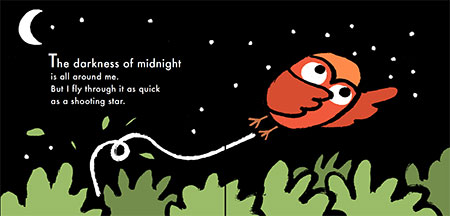 E: Is there a story behind the creation of HOOT OWL, MASTER OF DISGUISE?
E: Is there a story behind the creation of HOOT OWL, MASTER OF DISGUISE?Sean:I had a feeling an owl might make good character for a picture book. Then I came across this photograph of a starey-eyed hoot owl. (Trying to be scarier than he really is?!) It made me think an owl might be funny too.
This was about six years ago. My oldest son was three back then, and dancing with delight about dressing up (as three year olds do.) I sometimes find myself exploring a specific theme in my picture book stories. I went through a phase of writing stories about bedtime. (See THE WORLD CHAMPION OF STAYING AWAKE, published in 2011.) More recently I’ve written a string of stories exploring the funny side of fear (an example is my second book to be illustrated by Jean Jullien, which I can reveal will be called I WANT BE IN A SCARY STORY!) Right now, I’m trying out some stories about making friends. At the time I came up with HOOT OWL MASTER OF DISGUISE, I was interested in writing about dressing up. I had that image of a starry-eyed owl as a character in my mind. And a moment of writing magic happened. Two unconnected ideas met and joined. And a third idea…a story about a dressing-up hoot owl was created.
That meeting of unconnected ideas has led to quite a few of my picture book stories (and poems) over the years. If you have an interest in writing, it’s a good thing to try to make happen.
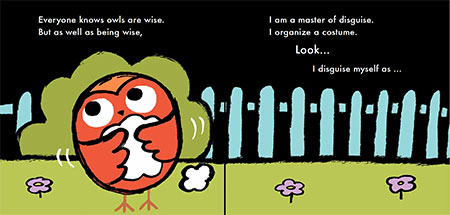 E: What was your path to publication?
E: What was your path to publication? Sean: A long and winding road in the case of HOOT OWL, MASTER OF DISGUISE. I wrote it back in 2010. My agent was Celia Catchpole. She tried to sell the story, but no publisher would have it. ‘How do you illustrate an owl disguised as a sheep?’ came the feedback. ‘Where does this owl produce its costumes from? Does it carry them in a bag?’
I remember reading the story out, myself, to my editor at Walker Books at the time, Lucy Ingrams. She wasn’t the most shockable of editors. But she did look slightly shocked by HOOT OWL MASTER OF DISGUISE! So the story went in the Walker Books filing cabinet for at least a year.
Then my current agent, James Catchpole, took a liking to the language and the humour of HOOT OWL, and he was unashamed enough to try selling it all over again. At some point he read it out at Walker Books again, and the bright-eyed Walker picture-book craftsman, David Lloyd, heard it. Apparently he walked into the office some weeks later saying, “What was that book Sean Taylor wrote about an owl dressing up as a carrot? Let’s have a read.”
It made them laugh. David Lloyd wasn’t worried where Hoot Owl’s costumes might come from. Walker Books bought the story. Maria Tunny (the editor) and Deirdre McDermott (the designer) managed to get Jean Jullien involved on the basis of some drawings they’d spotted on a menu in a burger restaurant! And HOOT OWL, MASTER OF DISGUISE happened.
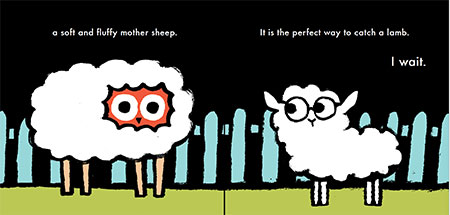 E: What is your favourite or most challenging part of being a creator?
E: What is your favourite or most challenging part of being a creator?Sean: I’m up at 6am when I’m writing. And the start of the day, with the hours ahead, is both my favourite and my most challenging moment. The way I get going often defines the day. I’ll generally feel excited about the possibilities that lie ahead. At best, the excitement stays with me as the writing hours pass. I have a rule not to look at emails or anything on the Internet until 11am. I have been known to break my own rule. But when I stick to it I usually have my better writing days.
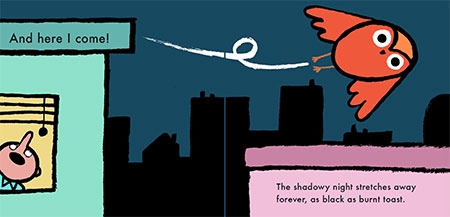 E: Is there something in particular about HOOT OWL, MASTER OF DISGUISE you hope readers will take away with them, perhaps something that isn’t immediately obvious?
E: Is there something in particular about HOOT OWL, MASTER OF DISGUISE you hope readers will take away with them, perhaps something that isn’t immediately obvious?Sean: Good writing offers readers things that not even the author is aware of. I hope my stories are good enough to do that.
 What are you working on next, or what would be your dream project?
What are you working on next, or what would be your dream project?Sean: I’m in love with the picture book form (see
this piece on my own blog) And I’m working on fresh picture book stories. But I’ve been asked to come up with some comic writing for 7-9 year olds, and am having some fun with that. I’m collaborating with a Muslim theatre company to make a book of Islamic humour and wisdom for young readers. And I have another writing love-affair going on with children’s theatre. I’ve written two children’s plays, which were produced in Brazil. There’s a possibility of a third in the pipeline – a puppet show based on my book for 6 – 9 year olds, WHERE THE BUGABOO LIVES!

These are all dream projects for me. That’s why I manage to feel excited at 6 in the morning!
Learn more about Sean Taylor at
http://www.seantaylorstories.com.


Peter Millet on...
What’s are three things you need to make a memorable book trailer?
Lights, camera and disco… Well the first two are items traditionally featured in most author-created videos but not necessarily the third one. With my new online trailer for
Johnny Danger: Lie Another Day I’ve decided to bring the infectious, finger-wagging disco beats back and help put the boogie into books to create a trailer unlike any other posted this month.

Late last year I completed my second middle grade book and made some notes about scenes that would be interesting to feature in a potential trailer. One of those scenes included a hip hop battle in the Amazon jungle involving spies, deadly warriors, and a man eating anaconda. Taking this concept a step further I decided it would be hilarious to make the world’s first ever one minute author music video for a book.
Usually I would bombard my fellow author friends on Twitter or Facebook with endless updates about my new book and supply millions of reasons why they should be as excited about it as I was. I decided that this time around I would only send one tweet and one Facebook post promoting the title, but that one action would be highly memorable. I also wanted to create a short piece of entertainment that children would enjoy and wish to share with their friends. In my book the hero uses a mixture of Uptown Funk and Gangnam Style dance moves to engage and outwit his adversaries. As pure luck would have it the week we began filming the video, the K-POP artist Psy released a catchy new single and openly encouraged listeners and fans to create their own, comical parody versions of it.
My fate was sealed - I had to be filmed dancing on camera as part of my commitment to the craft of writing.
Obviously I was unable to travel to the Amazon to film the sequence, so I decided to transport myself there via a green screen. For those who are not familiar with green screen technology - it’s simply a process of filming yourself in front of a green background, and then using a computer to remove any traces of the green colour. Effectively what you are standing in front of becomes invisible (the same method weather presenters use standing in front of their imaginary maps on TV). This allows you to be placed anywhere in the world on anything you desire.
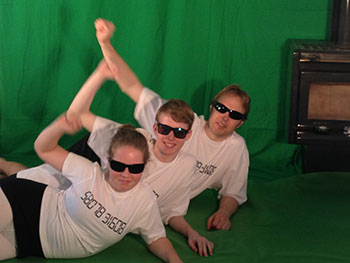
I engaged the services of my teenage children to help me film the humorous sequences. Most of the humour was generated watching me trying to emulate Peter Jackson or James Cameron by creating a hybrid green screen shooting studio in the middle of our living room with no experience at all. I think they realised I was technically challenged when I purchased two halogen lights to illuminate the green screen, and later realised the units I purchased did not include power cords. When I finally purchased the correct lights, the laughter continued as one of the fragile halogen bulbs blew up seconds before filming commenced and I had to return to the store dressed as James Bond needing an urgent thingamajig-wotsit replacement.

Somehow we managed to film us all separately dancing along to PSY’s song and then splice the footage together in the computer.

I was relatively surprised how believable the footage looked on-screen. I then decided to raise the stakes a little higher and asked my son if it would be possible to paste me disco dancing on top of a US Navy nuclear submarine. (Virginia Class for those sub-spotters out there.) It turns out it was possible - just extremely time-consuming. Every single scene (nearly 100) had to be hand adjusted to allow for the movement of my body being in sync with the motion of the submarine ploughing through the water. I eventually volunteered to do the painstaking adjustments myself, which I would relate to the task of individually replacing commas with semi colons throughout a lengthy Word document (a task ideally suited for a nerdy writer).

Four days later we had a pretty funny looking one-minute trailer in place. The icing on the cake was enlisting my good friend Brent Burridge who has over 30 years’ experience working in the radio industry to lay down vocals. He volunteered to play the gravelly-voiced narrator guy who adds a touch of dramatic tension to the clip that makes the whole product look ludicrously over the top.

I hope people enjoy watching this entertaining trailer. Particularly I hope children find it an amusing way to spend 60 seconds in front of their computers. For my next book release I will most likely revert to the traditional methods of bombarding folk via Twitter… or not!
Click the image below to learn more about Peter Millet and his latest Johnny Danger novel:



Creating the artwork for Abracadabra, It’s Spring!
by Susan Gal Abracadabra, It’s Spring! came to me as a manuscript. I immediately fell in love with the jaunty text and the playful, magic-themed words. Sometimes the text tells an illustrator what to draw, but more often than not its my job to bring the text to life. That’s the fun part for me--how do I bring a fresh, interesting perspective to words on a page? In art school I was trained to push past my initial solution to a problem and come up with my own unique interpretation. So…. spring is about nature; snowmelt and sunny days filled with flower buds bursting and the air humming with butterflies, birds, and bees. Animals awakening from their winter rests and gardens waiting to be planted. My job is to interpret these impressions and visually weave them with the text.
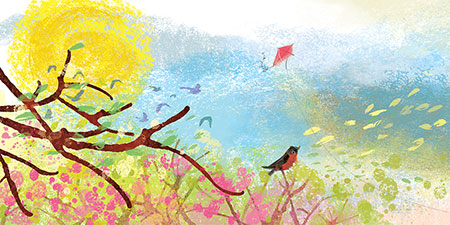
Along with interpreting the text, designing the spreads for
Abracadabra, It’s Spring! posed a particular challenge for me. Its a gate-fold book, meaning one half of the spread stays in place while the reader unfolds the page revealing another spread. The left side of the spread has to match with the unfolded, newly ‘revealed’ spread. Knowing that the reader will have to interact with the book in this way challenged me to make each spread, when opened, come alive with color--like the world re-awakening on a glorious spring day!
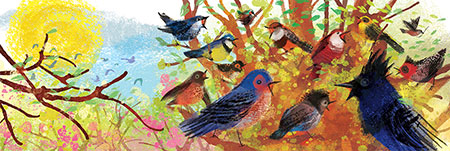
After completing work on Abracadabra, It’s Spring! I began work illustrating its companion book,
Hocus Pocus, Its Fall! I loved working with the same format and use of magic words, transitioning the imagery from spring to fall. Hocus Pocus It’s Fall! will be published Fall 2016.
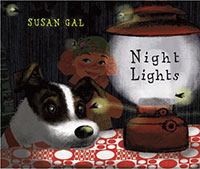
I began my career illustrating for magazines, newspapers, posters, and calendars. I also worked briefly in animation as an ‘in-betweener’ for Disney Animation Florida. But my first love has always been both writing and illustrating children’s picture books. In 2010 I took the plunge with my first book,
Night Lights. When I write and illustrate a book the pictures and characters come to me before the words arrive. I formulate a story in my head before putting pencil to paper. Then I jot down the story and begin to rewrite and refine it. From there I staple together a small paper dummy and start to lay out the pace and timing of the story. I don’t let myself start to sketch until I feel okay with the sentence structure. For me, the easier part of the process is creating the artwork, so I don’t allow myself the joy of drawing until the story is developed. Once the sentence structure is in place the real fun begins!

Character development and design is the most exciting part of storytelling for me. While working in animation I learned how important it is to know your characters. If they aren’t real to me, then there’s no point in spending time with them and bringing them to life in my story. Sometimes a character’s personality and body language is pretty complete from the start. Other times the character evolves as the dummy evolves. I spend a lot of time sketching the characters to get a feel for them. I like to stay very loose at this stage to keep the drawings fresh and allow for spontaneous things to happen.
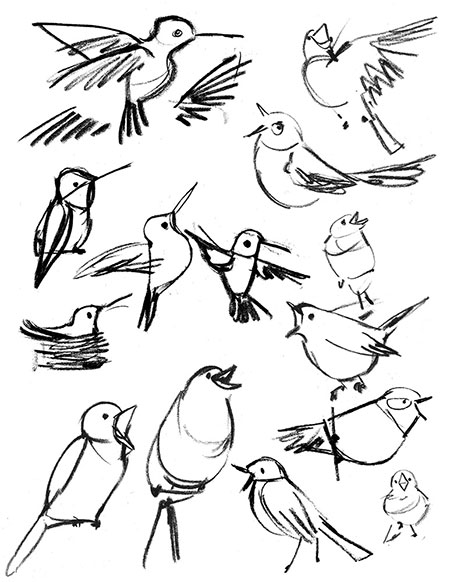
When I feel as though I have a grasp of the character, I scan my charcoal sketches on the computer and begin to digitally place them in a spread. Working digitally allows me the freedom to move the characters around in a composition. Eventually the drawing talks to me and tells me where it wants to go and I start to refine it. At this stage I’m still working in black and white so I can focus on the composition and design. Once the composition is established its time for me to start experimenting in Photoshop to render the final art. I’m intrigued by light, color, and texture and try to capture it in my work. Each new book gives me an opportunity to try my hand at a new technique.
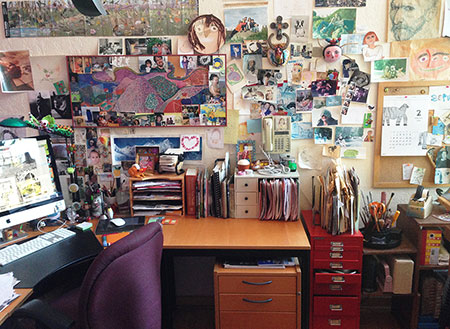
My studio is in my home located east of the Golden Gate Bridge. It has high ceilings and large windows with natural northern light. My drawing table faces east so when I start my day the studio is filling with sunlight as the day begins. Because I’m fascinated with light and color I enjoy experiencing how the light changes as my work day progresses. I paper my studio walls with photos, drawings, poems, etc….anything that inspires me. There are so many beautiful things that catch my eye—eventually I will need more wall space!
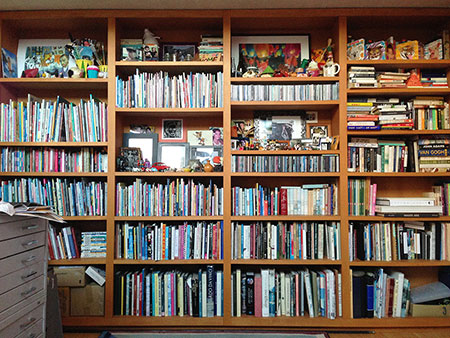
Learn more about Susan at
www.galgirlstudio.com.
Abracadabra, It's Spring! by Anne Sibley O'Brien and illustrated by Susan Gal, published by Abrams Appleseed (£8.99) -
CLICK HERE to purchase the book from Abrams.


It's black history month and my friend
Don Tate has a truly special book out that I have to share with you. It's called POET: THE REMARKABLE STORY OF GEORGE MOSES HORTON and it's published by Peachtree. (Gads, they do some good-looking books!) I emailed Don for a full on guest post, but he is riding high right now, super busy. As he said, "...things are so crazy right now. I'm on deadline to finish sketches for this next book before next Wednesday (when my travel schedule kicks in), and I have to start over on the sketches." So, I asked him some quick questions...
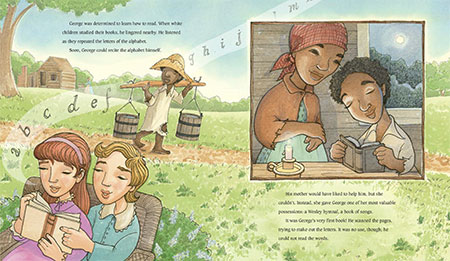 Me: How did you learn about George Moses Horton
Me: How did you learn about George Moses HortonDon: I wish I had a more interesting or profound answer to this question, but I learned about Horton through a writing partner, Chris Barton. I started researching Horton on that same day. I knew from day one that Horton's story would be loved by readers, but because of my heavy illustration schedule, I didn't know when I'd find time to write it. And then I had this fear that someone else might publish the story before I had a chance to start writing, so I found the time. Several years and many, many revisions later, the book was acquired by Peachtree Publishers.
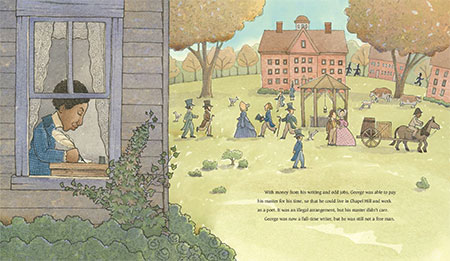 Me: What was your medium for this book?
Me: What was your medium for this book?Don: Initially I wanted to illustrate "Poet" digitally. I'd just purchased a Cintiq, and I was anxious to put it to use. I did all of the line work on my Cintiq, but I think it freaked out my art director, who had another look in mind. She loved my hand drawn artwork, as done in the book "Hope's Gift," so I decided to use the same medium, acrylic watercolor washes and ink (Micron) lines on watercolor paper. Acrylic dries hard and allows for layering without disturbing under painting. And I used colored pencil in places. I also wanted to find a way to include Horton's poetry, since I'd not included any in the text (intentionally). So I hand lettered portions of his poetry and worked them into the illustrations using Photoshop. I did eventually get to put that Cintiq to work on my following book, "Whoosh!"
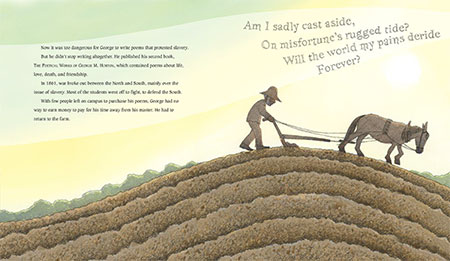 Me: With your busy schedule, how do you fit in creative time?
Me: With your busy schedule, how do you fit in creative time?Don: Balancing creative time with travel can be a challenge. To help, I recently purchased a Surface Pro 4. It's a tablet that allow me to sketch on it using Photoshop or Manga Studio. I completely sketched and laid out my last two books on it. It's not great for creating final art, but totally saved me with my last two books. I also have a great booking agent who helps with the details of travel, so that I can spend that time in creative mode. I take it one day at a time.
 Me: what are you working on next?
Me: what are you working on next?I have five more books under contract, and one to be announced soon. Most of them are nonfiction and involve little-known historical figures. I'm especially excited about an opportunity to work with Eloise Greenfield. That will be so cool!
 Learn more about Don at http://dontate.com.
Learn more about Don at http://dontate.com.
Jessica Young (author) and James Burks (illustrator) dropped by today to interview each other as they talk about their new series featuring Haggis and Tank. Enjoy!

 JB:
JB: Should we draw straws? Flip a coin? Or dance battle to see who goes first?
JY: I would totally dance battle, but since you’re in CA, and I’m in TN, you can go first. You’re first alphabetically.
JB: Are you more like Haggis or Tank? Why?
JY: I was going to ask you the same thing! My Haggis and Tank proportions vary from day to day. I tend to worry a lot and want things to be just so, especially in terms of my physical space—like Haggis. But if you get me at the right time I can be Tank-ish, too. I love trying new things and seeing new places, and I can be overly optimistic, impulsive, and goofy. Like Tank, I love dreaming up crazy adventures!

(Click the image to see it larger in a new window.) JY: All right, I'm still going to ask it: What about you? Haggis or Tank?
JB: We are just two peas in a pod. I’m also a little bit Haggis and a little bit Tank. (That sounds like an altered version of a Donny and Marie song.) I like to feel like I’m in control of what’s happening in my life like Haggis. But I also love to live life to the fullest like Tank. I’m always up for an adventure. Life is short and I want to collect as many experiences and memories as I can.
JB: How did you come up with the idea for Haggis and Tank? What made you choose a Scottish Terrier and a Great Dane?
JY: Haggis and Tank started as a picture book—Not a Knot—about a girl learning to tie her shoelaces. After wrestling with the all-dialogue text, I realized it wasn’t working. My brilliant critique partners and agent suggested turning it into a chapter book. The main characters evolved into a doggie duo, the setting changed to a pirate ship in order to keep the knot/not wordplay (the only thing I kept from the original text), and I wove in other homophone-based misunderstandings throughout the story. I’ve always been fascinated with Scotland, hence the Scottie named Haggis.
(Elizabeth piping in here: YAY!) And one of my roommates after grad school used to have a Great Dane who was a real character. She probably influenced my choice for Tank. Also, I wanted the characters’ physiques to be as different as their personalities.
 JY:
JY: When you get a new manuscript, what's your process? And when you write and illustrate a story, does the drawing ever come first?
JB: The first thing I do when I get a MS is read through it. Then I ask myself: Are the characters interesting? Will it be fun to work on? Is it different than what I’ve done before? If I can answer yes to all of those then I’ll start working on designs for the characters. I’ll explore different shapes and features until I find something that I can draw from almost any angle with a wide range of expressions. I want to make sure the characters are able to move around on the page and act without limitations.

Once everyone is satisfied with the designs, I’ll move on to roughing out the pages. This can be in my sketchbook or in Photoshop. Once the roughs are approved, I’ll do all the final line art and color in Photoshop.
For books that I write and illustrate, I always start with the character sketch first. If I find the character interesting and feel that he/she/it has a story to tell, I’ll write out an outline with the basic plot points. I’ll send this to my agent to see what she thinks. Once I have a story that my agent and I are happy with then I’ll move on to drawing. From there it’s pretty much the same as above.
 JB:
JB: Do you want to tell about how we ended up working together on this project?
JY: Yes! I'd been a fan of your work for a long time, and we’d met at the
Society of Children’s Book Writers and Illustrators conference in L.A. After seeing some of the sketches you were posting on Facebook, I mentioned to our amazing agent that I thought you'd do a great Haggis and Tank. She asked you if you'd be interested in creating a sample we could submit with the text. And the next thing I knew, Haggis and Tank were staring at me from my computer screen, making me laugh with their hilarious expressions! They were perfect. And our wonderful editor, Katie Carella, thought so, too.

(I just wanted to add this initial sketch that James did of Haggis and Tank. When he sent it to me (Jessica) through our agent and I opened it, it was the first time I "met" Haggis and Tank!)JY: So what creators inspire you?
JB: I take inspiration wherever I can find it. Charles Schulz and the pre-1970s Peanuts strips are a big influence. I just like how simple they are in terms of the layout and the characters. There’s no unnecessary clutter. Each panel only contains what’s needed to get the idea across. Which is something that I make a point of doing in my own work. I’m also a big fan of Tim Burton. I like his dark sense of humor and the looseness of his line drawings. They just have so much life in them. Walt Disney is another influence. He had a vision and thought outside the box. He made it possible for so many great artists to create such phenomenal works of film and art. I wouldn’t be the artist I am today if it weren’t for the inspiration I’ve gained from studying their work.
 JB:
JB: What inspires you to create your books? Are there certain authors or illustrators that you admire?
JY: My tastes and interests are pretty eclectic, but as far as inspirations for this series, I’ve always loved wordplay and fun pairs of characters. Early influences include books that experiment with language in funny ways, like Edward Lear’s The Quangle Wangle’s Hat and Shel Silverstein’s Where the Sidewalk Ends, as well as great characters like James Marshall’s George and Martha, Arnold Lobel’s Frog and Toad, and Munro Leaf’s Ferdinand. As far as contemporary authors and illustrators I admire, there are too many to name!

(Click the image to see it larger in a new window.) JY: What’s your favorite medium, and why?
JB: My books are pretty much all done digitally with the exception of the initial sketches which are done in my sketchbook. I do love the idea of watercolor and would love to one day do a book using it. I just love the looseness of it. I always want to retain as much life in my work as possible. I want the characters to live and breathe on the page, and I think watercolor could push it even further. I just need to work with it a bit more before I can attempt to use it for an entire book.
JB: What do you like to do when you’re not writing children’s books?
JY: My other favorite things to do are hanging out with my family, cooking, playing music with my kids, and drawing when I get the chance. I also love dancing, swimming, and riding my bike, but I need to work on doing those activities more often.
JY: I know exercise is an important part of your life. How do you balance work and family and keeping healthy?
JB: Three years ago I looked in the mirror and didn’t like what I saw. So I made it a priority to get in shape and to take better care of myself. I don’t so much watch what I eat as much as I make sure to get plenty of exercise. I run, bike, or swim pretty much six days a week. The key for me is to not make excuses why I can’t exercise. I make time for it. I make it a priority. I make it a habit just like brushing my teeth. It makes me feel good and most days this spills over into my work and the time I spend with my family. It has changed my life.
JY: Okay, speed round: You're Tank. Where would you convince Haggis to go on an adventure, and what would you eat?
JB: If I were Tank I think I’d convince Haggis to bike across the United States. We’d eat all of the great foods from all the places we’d pass through. Haggis could ride in the sidecar and I’d do all the pedaling. It would be an epic adventure!
JY: Do you like black licorice?
JB: No. Black licorice is my kryptonite. (Well, that and drawing horses.)
JY: As you know, my kids are huge fans of yours. They especially love your Bird & Squirrel series. What are you working on now?
JB: Currently I’m roughing out the fourth Bird and Squirrel book. I’m also writing the follow up to my next picture book, Pigs and a Blanket (April 5) for Disney/Hyperion.
 JB:
JB: What about you?
JY: I have a couple of picture book manuscripts I’m working on. And an unfinished novel I’ll go back to one day. And some other top-secret surprises!
JY: Thanks so much for doing this with me! I learned a lot!
JB: I had a blast. I can’t wait to see what Haggis and Tank have in store for us in the future. Onward and upward!
 About Haggis and Tank Unleashed:
About Haggis and Tank Unleashed: Tank is a clumsy, outgoing Great Dane. Haggis is a dapper and grumpy Scottie dog. In the first book in the series, Haggis and Tank set sail as pirates. At first, Haggis doesn’t see what Tank does–that an adventure awaits them with just a little imagination! But soon, Haggis joins in the fun and the two friends talk like pirates, swab the deck, and search for buried treasure. This series is full of wordplay and homophones that make Haggis and Tank’s adventures even more fun!
Reviews:
Kids dipping a toe into the waters of early chapter books will find themselves challenged by the text while simultaneously enticed by the alluring art. These salty sea dogs put the bite back in buccaneering. — Kirkus Reviews (Whole review here.) Odd-couple antics, loads of goofy humor, and an appealing comics/early reader format make for an all-around entertaining read. — Publishers Weekly (Whole review here.) “a must-have for the difficult-to-fill niche for readers transitioning from picture books and beginning readers to early chapter books.” –School Library Journal
Illustrations from Haggis and Tank Unleashed written by Jessica Young and illustrated by James Burks. Illustrations © 2016 by James Burks. Used with permission from Branches/Scholastic Inc. 

HIAWATHA AND THE PEACEMAKER - SYMBOLISM
by David Shannon When I was approached by Abrams about illustrating this book, my first inclination was to turn it down. I was in the middle of several projects and busy writing my own stories, but I agreed to meet with the author, Robbie Robertson. After all, it’s not everyday you get a chance to meet one of the rock ‘n’ roll’s greatest guitarists, and his telling of the Hiawatha story was very compelling. It reminded me of some of the first books I’d illustrated, particularly The Rough-Face Girl, by Rafe Martin.
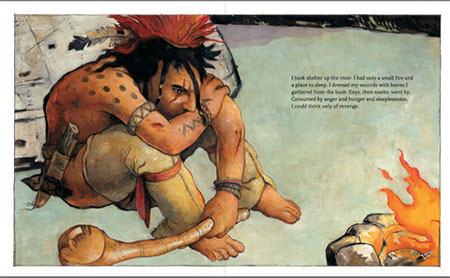
Robbie and I met at his recording studio, and he told me how as a boy he’d listened to an elder tell the story of Hiawatha in a lodge in Canada. Robbie is a very good storyteller - whether it’s in a song, a book, or just sitting in a room – and soon I was beginning to mentally re-arrange my work schedule. Then he played the song he’d recorded for the book and it was clear that working with him would be a unique experience. So, I agreed to illustrate Hiawatha and the Peacemaker.
Anytime I work on a cultural folktale, it begins with research. Librarians use books like this as teaching tools, so I try to get the details as accurate as possible (it’s a great excuse to buy a bunch of books and visit museums). At the same time, I don’t want to just copy what I’ve found, so there’s some imagination involved as well. I also try to use clothing, artifacts, and setting to enhance the story through symbolism.
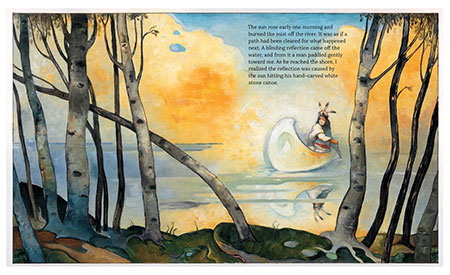
Hiawatha is a big, dramatic story about war and peace, hate and righteousness. There are many symbolic elements of magical realism – a stone canoe, a villain with snakes in his hair, a solar eclipse – that needed to be front and center in the illustrations. It took a lot of work in both the pencil sketches and the finished oil paintings to make these pieces believable and yet maintain a feeling of “otherworldliness”.

As with many Indian tales, Nature plays a large part and I tried to use trees, water, fire, and stone as secondary symbols to reinforce the spiritual side of the story.

The theme that drew me to the story most, however, is the idea of healing through forgiveness. Hiawatha suffers a great loss at the beginning of the story – the murder of his family – and must heal himself while he seeks to bring peace to the warring tribes. He does this by forgiving his enemy rather than fighting him. By healing his enemy’s psychic wounds he heals himself. His enemy, the warlord Tadodaho, is physically corrupted by his own evil and power. His body is contorted and snakes slither in and out of his hair. Hiawatha gives him medicine and drives away the snakes – pretty clear symbolism there!

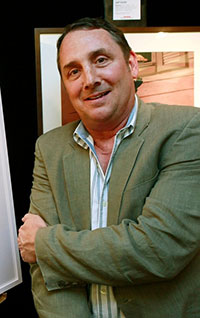
But Hiawatha’s healing is more subtle and internal and is symbolized by a wound across his eye. As the story progresses and he learns to see things differently according to the teachings of the Peacemaker, the wound slowly heals. In the end, it is his act of forgiveness toward Tadodaho that breaks the cycle of war and allows all the tribes, and Hiawatha in particular, to embrace his own life again.
CLICK HERE to buy the book.
Hiawatha and the Peacemaker by Robbie Robertson, illustrated by David Shannon, published by Abrams Books for Young Readers. 

Night on Fire
by Ronald Kidd It started with a bucket of water, a stack of Dixie cups, and the girl who carried them.
Her name is Janie Forsyth, and she appeared in Stanley Nelson’s magnificent documentary, Freedom Riders. Her family owned a neighborhood market on the outskirts of Anniston, Alabama. On Mother’s Day 1961, a group of African American and white students calling themselves Freedom Riders came to Anniston on a trip through the South to challenge segregation practices. As Janie looked on, a mob forced the bus off the road right in front of the market. They set the bus on fire, and when the riders came stumbling out, the mob beat them. A crowd watched. No one did anything to help the riders.
Except Janie.
She got a bucket, filled it with water, took some Dixie cups, and went among the riders, offering them water and comfort. Someone filmed the scene, and I saw it fifty years later in Nelson’s documentary. I was so moved by Janie’s courage that I decided then and there to write a book about it. At first I thought I might tell Janie’s story. Then I decided to create a fictional character who knew Janie and lived in her neighborhood. That character is thirteen-year-old Billie Sims, who, along with her family and best friend, Grant McCall, lives up the hill and is at the market on that terrible day.
That night, Billie asks herself some tough questions: How could people do such a thing? How could others stand by and watch? How could I stand by and watch?
To answer the questions, Billie goes on a bus ride of her own with Jarmaine Jones, a new friend who is the daughter of her family’s maid, Lavender. Jarmaine and Billie decide together that there are two kinds of people in the world: watchers and riders. They want to be riders.
The bus takes them to Montgomery, where the Freedom Riders had been attacked and a rally to support them would be held at First Baptist Church. Attending the rally are Civil Rights leaders Ralph Abernathy, James Farmer, Diane Nash, Martin Luther King Jr. The church filled, a mob surrounded it, and the night burst into flame.
Billie and Jarmaine are there. They see what fear can do and how freedom could overcome it.
“I thought freedom was just a word, but it’s not,” says Billie. “My friend Jarmaine taught me that. Freedom is hands and feet, bodies and faces, wounds and scars. It’s a bell, and I rang it. It’s a bus, and I climbed on.”
Billie’s journey was my journey too. My family is from the South, and, like all Americans, we have been infected by racism. As Lavender Jones says, prejudice is a disease. You catch it from your parents and friends. The question isn’t whether you have it, but whether you’ll pass it on.
I don’t want to pass it on, and neither does Billie. I am grateful to her, as I am grateful to all my characters for allowing me to walk alongside them.

It’s why I write. In my reading, I search for a time and place where important things were bubbling up and about to burst, then I imagine what it would have been like to be there. I’m in Anniston with the Freedom Riders. I’m in Dayton, Tennessee, to witness the Scopes Monkey Trial. I’m in Memphis when Elvis Presley cuts his first record. I’m in Sierra Madre, California, to watch the filming of The Invasion of the Body Snatchers. I’m in Bristol, Tennessee, to meet the Carter Family and see the birth of country music.
My characters grow from the soil of these places, and important things are bubbling up in them as well, things that spill over into my world and the world of my readers. Racism in Anniston. Doubt in Dayton. Identity in Memphis. Paranoia in Sierra Madre. Faith in Bristol.
I sit in a chair in Nashville, Tennessee, and I travel across America, dipping down when something grabs my attention. It’s a big, rough, troubled, beautiful country, and I am eager to explore it.
Ronald's fave writing spot:

Learn more about Ronald at
http://www.albertwhitman.com/author/ronald-kidd/.


For this, my Christmas Eve post, I have a lovely gift for you, dear readers...
Here at the University of
Edinburgh College of Art, I have the distinct pleasure of being mentored by Vivian French. Vivian is the award-winning author of over 270 children’s book titles including her latest picture book, THE MOST WONDERFUL THING IN THE WORLD, illustrated by
Angela Barrett (Candlewick Press). Here’s the blurb:
Once upon a time, a king and a queen promise to marry their daughter to the young man who can show them the most wonderful thing in the world. Suitors arrive at the palace, one after the other, with elaborate gifts of jewels, inventions, and even mythical beasts, but nothing feels quite right to the overwhelmed majesties. It is only when a shy young man, who isn’t a suitor at all, steps forward that the king and queen finally understand what the most wonderful thing in the world actually is. Vivian French’s touching fairy tale is made all the more enchanting by the many subtle surprises included in Angela Barrett’s exquisite illustrations.
Since I have such lovely access to Vivian, I wanted to ask her some questions to share with all of you…
Vivian, how did the idea for THE MOST WONDERFUL THING IN THE WORLD come to you?The story of TMWT is based on a traditional story that Angela Barrett loved as a child. She brought it into Walker Books and we had a look at it together - and I thought I could develop it, and have fun with it. In the original the King and queen are besieged by suitors, but there's not much mention of what they bring; Angela thought this would give her a lot of scope for inventive illustration, and I loved the idea of changing the story so that it had a new life. There's a lot about gardens in the original; I preferred the idea of Lucia and Salvatore exploring the city together, and gradually falling in love without knowing too much about each other.
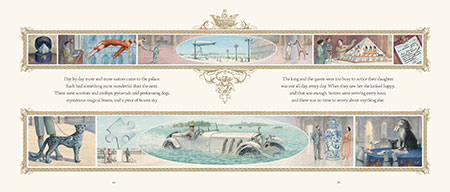 Was it a story that came easily, or did you have to noodle with it a good deal?
Was it a story that came easily, or did you have to noodle with it a good deal?It was much too long to begin with. I had to do a good deal of slicing and cutting, especially once Angela's amazing pictures starting arriving. I had to change the text to fit; she often drew something entirely different from the gifts that I'd described. Also the design required the text to be shaped on certain pages so it didn't argue with the curves of the illustration; I spent a lot of time counting letters and spaces!
In our workshop, you talk about coming up with a beginning and an ending first, before coming up with the middle of a story. Can you talk about that a little?I like to have a clear idea in my head about where the story is going to go ... rather like knowing which country you're going to end up in when you travel. (Even though you don't know the exact location.) I also think it's important to know what emotions are going to be called upon - both in the characters, and in the reader.
 Do stories come to you or do you seek them out?
Do stories come to you or do you seek them out?I'm not sure what this question means. Stories unravel in my head ... I'm never aware of chasing them down.
What was your writing journey like when you were starting out? How did you sell your first book?A friend who was a published children's author told me to try and write ... I'd been a story teller and an actor (children's theatre) for a long time. She sent my first attempts to her publisher and they said no, but Walker Books were in the same building, and they said yes. Something of a surprise, as I'd never really considered writing children's books. I'd written plays, though.
You’ve been working with me on creating “Heart Illustrations.” Can you explain what that means?I think I was trying to explain the need to touch in to deep emotions. The characters in a story have to speak to the heart of the reader, to connect, to make them feel something they didn't feel when they looked at the first page - and the emotions have to feel true and not contrived or forced. A book is a journey that the characters and the reader take together. Some books, of course, are little more than a visual joke (and very funny they are too! I wouldn't be without them) but I'm talking about the books that children look at/read over and over again because there's an essential truth within them.
 Can you share a bit about Picture Hooks and how it came to be? (It’s one of the reasons I chose to come to the University of Edinburgh!)
Can you share a bit about Picture Hooks and how it came to be? (It’s one of the reasons I chose to come to the University of Edinburgh!)Lucy Juckes and I felt there was an uncomfortable void between leaving art college and going out into the world; we wanted to help prepare emerging talent so they could feel confident of their work, their portfolio, and know something about what was on offer. We arrange for five illustrators (not necessarily straight out of college; some have been around a little longer, but for various reasons need support and a refresh) to be mentored for a year by five professional illustrators with substantial experience. We're very careful how we put the mentor/mentee together; it has to be a mutually comfortable fit. And, at the end of the year, there's an exhibition in the National Gallery of Scotland - lucky us! Last time we had over 90,000 visitors. We're hoping to do even better this time ... the exhibition is on until the end of February.
There's lots more information on
www.picturehooks.org.uk. We're incredibly fortunate to have the support of the illustration department at ECA, and the National Gallery of Scotland. And, of course, Creative Scotland.
What are you working on now?A short novel for junior readers, a couple of early readers, a non-fiction story or two ... and there's a play that is REALLY late on delivery dates!
I asked Vivian to share a photo of her fave writing spot and she said...It's the train. Any train. Or a long haul flight ...

Learn more about Vivian at her website:
http://www.vivianfrench.co.uk.


On Creating 'Twas the Night Before Christmas
by Daniel Kirk It must have been twenty years ago that I first came up with the notion of a woodsman-Santa, wearing plaid coat and a cap with earflaps. I did an oil on canvas painting of him, standing with a camping lantern on a dark, snowy night, and made it into the holiday card that I used to send to friends and family. One of my editors, Howard Reeves, suggested that I should write a story about my character. Over the decades I’ve tried a couple of times to tell the story of this Santa, but I never came up with the perfect idea.
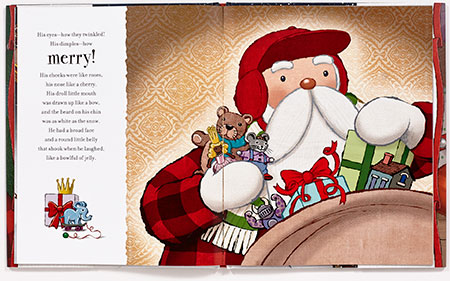
Just a few years ago I was discussing possible Christmas book projects with that same editor, Howard Reeves, and it was suggested that I might take one of the perennial favorites, like “Twelve Days of Christmas” or “’Twas the Night Before Christmas” and create my own version. Now I must have at least a dozen versions of “’Twas the Night Before Christmas” on my own bookshelves, and I went to the library to find all of them that I could. I must have checked out another twenty before I felt like I knew what I was up against! I didn’t see any point in illustrating a classic like this unless I could bring something new to it.
My favorite version happens to be the one Anita Lobel illustrated in 1984, featuring Brooklyn as the backdrop to the familiar tale. Gyo Fujukowa’s version is also quite lovely and stylized, as is Leonard Weisgard’s classic. I’d have to say that I tend to like the versions that add something new or different to the old poem. If something is worth doing, I believe it’s important to put your own stamp on it! It seems to me that it’s an illustrator’s job to make text come alive in a distinctive, individual way.
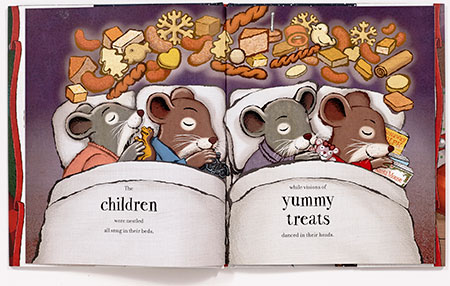
I’ve been writing and illustrating children’s books a long time, and my most popular books have been a series of five stories called “Library Mouse”. I wondered whether I could make the narrator of “’Twas the Night Before Christmas” a papa mouse, instead of a man. I thought this might give the story a new perspective and allow me to expand the Library Mouse world to include more characters. My editor informed me that if I had to make a few minor text changes it would be okay, so I did. And then I had to find a way to tell the story, visually, from a mouse point of view.
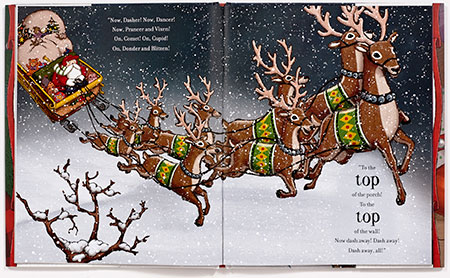
I also wondered if it might be time to share my view of a woodsman-Santa. So far nobody has complained about my version not being “true” to the original, and I am glad for that. Though recently at a bookstore reading a little boy came up to me afterwards and asked why Santa’s nose was a red ball, just like Rudolph the Red Nosed Reindeer. Kids are very observant!

I’ve experimented with a lot of different media over the years. I began my children’s book career making oil paintings on canvas, then went to gouache, pastel, colored pencil, collage and many other things! My last five or six books have begun with pen and ink drawings, which I scan into my computer and add color and textures in Photoshop. It’s fun for me as an illustrator to try new techniques. As they say, if you always hit the target, you’re standing too close, and I like to challenge myself if I can.
I have a painting studio in the barn/garage out at the end of our property. But these days I find that it’s nice to set up the computer in the dining room in the house and work there, where the natural light is plentiful, and I am always close to the kitchen. I work better if I always have snacks on hand! And as we enter this holiday season, I am tempted to bake some Christmas cookies to nibble on while working on my next book project.
Learn more about Daniel at http://danielkirk.com.Twas the Night Before Christmas by Clement Moore and illustrated by Daniel Kirk, published by Abrams Books for Young Readers (£10.99) CLICK HERE to purchase the book directly from Abrams.

How I wrote Blue Penguin
by Petr Horacek “Blue Penguin” is my latest book and was published exactly two years after I had the idea of writing a book about a penguin.
I travel every autumn to the Czech Republic, the country where I was born. I love autumn and I love the Czech countryside.

My good friend lets me stay in his cottage. The house is on a hill, it has a small apple orchard and woods surround it.
It’s one of the most beautiful places I know. I stay there on my own. I walk and paint in the woods and I think about new ideas for my picture books.

Every year I come home with some ideas. Not all of them are good of course, but I always have some material to work with.
Two years ago I was in this cottage and I was raking leaves in the orchard. I thought about one of my friends who was always himself and because of it, he didn’t make his life exactly easy. People don’t like it if somebody is different. My friend Richard was a bit different and I liked being his friend.
The idea of writing a book about a penguin that was different came from here I think.

I enjoyed making up the story about a blue penguin, his loneliness, his dreaming up a whale who will rescue him one day and take him far away from his loneliness. He will finally meet a friend who understands him and appreciates his talent. These two will become friends.

In the very first version the blue penguin would finally separate from his new friend and he would leave with the white whale, but the story was a bit too sad.

My editor and I worked on the text for a very long time. I’m very lucky to be published by Walker Books and work with such a great team of people and editors who won’t let go until the book is just right.

I wrote many versions and it was quite frustrating since I was desperate to start on the artwork. I knew exactly how I would like to paint the pictures and I was looking forward to it.

Here are some of the sketches for the book.

I think I must have at least fifteen versions of Blue Penguin.

Finally, after many months on and off rewriting the text, I was allowed to get on with the artwork.

Painting the picture was fun. I like to get messy and I use collage, print and scratch in to the picture. I like texture and colours and this book needed it.

I don’t know how long it took me to finish the illustrations, but I remember feeling a bit sad when it was all over. Somehow I wished the book had twice as many pages.

Quite unusually even when the book was finished and ready to be printed, we decided to make a few more changes. That wasn’t easy, because I had to get rid of this picture.

It wasn’t easy, but it was a good decision. The book was finally finished.
I enjoyed writing and illustrating Blue Penguin and I hope you will enjoy reading it.



It Takes a Whole Lot of People to Make a Book
by Lauren Mills In the midst of writing and illustrating this novel, I was spending summers teaching drawing in the Children’s Book Writing and Illustrating MFA program at Hollins University in Roanoke, Virginia, which gave me the perfect opportunity to do further research on Appalachian culture. I audited Dr. Tina L. Hanlon’s class Appalachian Traditions and Adaptations in Children’s Literature, and I thank her for sharing many of her books and films and for bringing me to the Exhibition Coal Mine in Beckley, West Virginia. I also visited the Youth Museum and the Mountain Homestead, which provided pictorial reference information on the church, some of the log cabins, and the classroom.
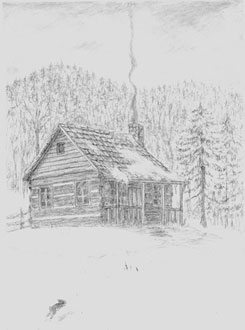
Some of the herbal information comes from my recent research on Appalachian and specifically Cherokee herbal medicines, but much of it comes from my years of training with herbalists, especially Rosemary Gladstar and the teachers at her New England Women’s Herbal Conference, as well as my studies with Native American healers and shamans of plant spirit medicine.

The Foxfire books, a classic series consisting of high school students’ interviews of Appalachian people sharing their memories and “affairs of plain living,” were of great help. They hold a wealth of information on the crafts and lore of the Appalachian region.
The Cherokee (Lifeways series), by Raymond Bial, and
The Cherokee (First Americans series), by Sarah De Capua, were also helpful books on Cherokee traditions. I am grateful to John Rice Irwin, founder of the Museum of Appalachia, for reading
The Rag Coat for historical accuracy years earlier. Mr. Irwin’s book
A People and Their Quilts was one of the most useful texts on quilting that I consulted. Some of the patterns he discusses were used as inspiration for the chapter titles in
Minna’s Patchwork Coat.
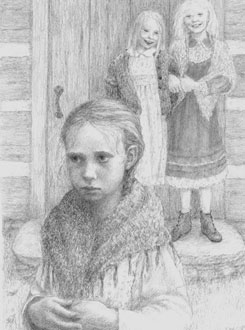
The school I used as a model for the Rabbit Ridge School is the Nash Hill School, built in 1786 in Williamsburg, Massachusetts. I am grateful to my friends, the Marti and Black families, for preserving this school on their property, and specifically to Penelope (Souci), Charlotte (Lottie), and Hannah, Olivia, and Sherrie (Quilting Mothers) for posing as many of the characters and supplying their chickens, garden, old stove, and family quilt as handy references.
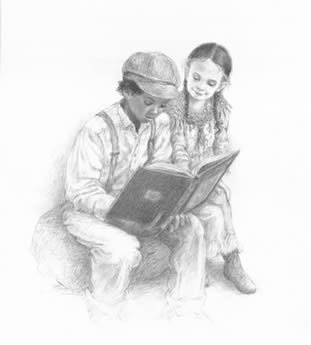
I also wish to thank the Hartsbrook School for allowing me access to their goats, lambs, chickens, sheep, and playground, where many of the children and their parents acted out the scenes. I am indebted to all of the other expert actors who have helped make the book come alive, including Alexandra Irvine (as the perfect Minna); her mother, Anna Maria (Aunt Nora); Alexandra’s father, Peter (Minna’s papa); Alexandra’s grandpa John F. Nygren (Clyde’s grandpa); Talon Neville (Lester); Jasper Piermarini (Shane); Sara Rose Page (Minna’s mama); her daughters, Arya Rose and Layla Grace Page (younger children); Bisbee Hooper and Henry Lax-Holmes (Clemmie); Sophia Lax-Holmes (younger girl); Jonah Toran (Clyde); his sister, Ilana (younger girl); Stephen Katz (Shane’s father); and Louise Chicoine (Miss Campbell).
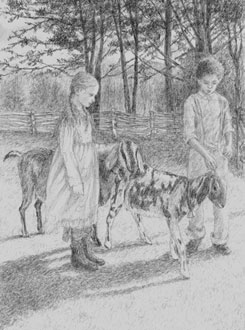
While I was working on the drawings, I listened to lots of bluegrass music and wore clothing similar to what would have been worn during this time period, supplied to me by Magnolia Pearl, a unique company in Texas. Robin Brown’s designs include clothing handmade from homespun linen, vintage lace, embroidery, and even patches! I thank Faith Scott, who sent boxes of treasures for me to use as inspiration for the characters’ attire. I named the goats Magnolia and Pearl in gratitude.
I also want to thank the many people at Little, Brown Books for Young Readers for their wonderful work on this book, especially my insightful and encouraging editors, Andrea Spooner and Deirdre Jones, not only for their expert guidance but also for allowing me to find my voice. I also thank senior designer Liz Casal for helping me find the best solutions, and copy editor Erica Stahler and production editor Barbara Bakowski for their astute and helpful notes.
I thank my writing group, composed of Dixie Brown, Barbara Goldin, Amy Gordon, and Dennis Nolan, for listening and commenting with the utmost care.
I wish to thank my artist friend Koo Schadler, who knows the secret of illuminating the lights against the darks and the bright colors against the dull grays.
I thank Dolly Parton for her inspiring song “The Coat of Many Colors.”
I thank my parents for giving me an understanding of the soft stuffing that is inside
Minna’s Patchwork Coat; Aunt Marcy (after whom I named Minna’s mama) for instilling in me a love of quilts; Nana for giving me a love of embroidery and the hills of West Virginia; and my sister, Brookie, who encouraged me to climb my own mountain and who tried her best to hike the entire Appalachian Trail from Georgia to Maine.

Most of all I thank my partner, Dennis Nolan, for always being there in the most helpful, loving, patient, and wise way a body could be, and for telling me I must have been Minna in another life!
What motivated me - Just as the individual stories of the children in the book, Minna's Patchwork Coat, are part of Minna's coat and woven into her story, much of my own life experiences and philosophies are interwoven and patched into the book as well. My heart and soul went into the process. For me, the book was about making sense of bullying and trying to find something good in someone who has been mean, and of keeping faith and carrying a light after you've prayed and prayed for a loved one to survive, has died anyway, and of being resilient and hopeful when times are tough. It's about my own grief over the loss of a simpler way of living and ofbeing closer to nature in a world that has replaced the walk through the woods to school or a horse ride to the village with sitting in traffic on the highway, a world where singing, dancing, sewing, and sharing stories together has been replaced with push-button entertainment. One could think I romanticize the poverty of Appalachia in the early 1900's, but at times in my life I have experienced circumstances much worse than what I've described in the book, so it is not that I look at the world with rose-colored lenses, but that I am trying to give a child, who may need a guiding light, a new way of thinking to get through hardship with hope, and for our push-button society - a glimpse into another way of life that we could make for ourselves with some effort.
 About This Book
About This Book The cover was painted in oil, and the interior illustrations were rendered in graphite pencil on Arches paper.
About the Author Lauren A. Mills is the award-winning author and illustrator of
The Rag Coat and
The Goblin Baby, and she has retold and illustrated
Thumbelina, Tatterhood and the Hobgoblins, and
The Book of Little Folk. She is also the author of
Fairy Wings, Fia and the Imp, and
The Dog Prince, all of which she co-illustrated with her husband,
Dennis Nolan. Her work has been exhibited in galleries and museums across the country, including the National Museum of Women in the Arts. Her stories have been performed by storytellers and actors across the country and on the radio, and
The Rag Coat was performed as a ballet by the University of Utah. Mills is a visiting associate professor of drawing in the
Children’s Book Writing and Illustrating MFA program at Hollins University in Roanoke, Virginia. She invites you to visit her website at
laurenmillsart.com.
---
CLICK HERE to see more images from the book and read the fantastic reviews!


 Search and Spot, Animals!
Search and Spot, Animals!
by Laura Ljungkvist I can’t believe that search Search and Spot, Animals! Is my tenth book. It takes such a long time between completion and publication of a book, that getting the box with your 20 copies is a moment full of excitement and a little angst. What if I don’t like it?
Going back to my editorial illustrating days, I always had a hard time looking at my things after they are just published in a publication or wherever it was. I am so hard on myself. So, after a quick glance, I put it away in a drawer in my flat files and when some time had passed and I look at it again, I can be more neutral and less emotional.
So it was with sweaty palms that I opened the box Houghton, Mifflin, Harcourt. What if the colors were off. What if the bugs were impossible to find, what if….?
Of my ten published children’s books, 9 are written by me. I was asked to illustrate Mem Fox's book,
Yoo-Hoo, Lady Bug! a couple of years ago. It writing, it was a “search and find book but with Mem’s beautiful” writing. I enjoyed doing that so much that I got the idea to do my own “search and find book”.

One of my teachers in art school once said to me that I have a fear of white space. He was right. If you look at my body of work, the art tends to fill up the space. As a child I was drawing patterns and obsessively filling page after page.
I also drew lots of animals, especially horses. I have many, many animal drawings, in my drawers going back to my childhood. So,
my “search and find” book was going to be a work of love – patterns and animals! Voila – Search and Spot, Animals!
When everything has been approved and agreed on with my publishers team on a book project, it usually takes me about 3 months to do all the final artwork for a children’s book.
However, my first 2 children’s books are painted in gouache, and it took me a whole day just to paint half a background or the pattern on a dress. When I got a MAC computer and started working in Photoshop things went much faster. Unless I scan in a drawing made on paper, I have a drawing tablet with a special pen that acts just like a mouse, so I am still drawing, I’m just using a different pen - “Digitally drawn”!
Very often I find that things “come to me”, and I get ideas and inspiration as I am working and going to final on a book. That’s why I try keep sketches quite general, so I am not too “locked in” but can allow those ideas to flourish.
One of my favorite spreads in the book are the horses. That spread is a perfect example of doing something that I think is beautiful, and getting that extra idea for the text, concept and questions as I am working.

I like the challenge on this spread. Readers are asked to find different colored horses. Some horses have a solid color and some are drawn in just a line. Could lead to some interesting questions for children? I a horse really pink if it’s drawn with a just a pink line?
And then there are the dogs! Try and find the photographed French Bulldog!
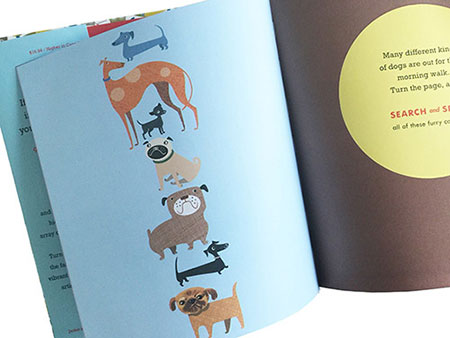

My goal was to make different kinds of challenges for the reader. In some searches you have to turn the page and find what you are asked to look for on the next spread. In some cases there are some animals shown and you have to find them on the same spread. Then there are searches were you are told in the text what to look for.

And then, there is my favorite thing that I try to do in all my books. One final search that makes the reader go back and search through the whole book again! So much fun!
The follow up to “Animals!” is just completed, Search and Spot, Go! It’s full of boats, helicopters, busses, bikes and tractors. So now I’m waiting to open open another package with sweaty palms - test prints (or f&g’s as we say).
Oh, BTW, I loved “Animals!” when I opened the box! It accomplished just what I set out to do and I had so much fun doing it!
Check out Laura's groovy studio space with her dog Lola:



View Next 25 Posts













 That if you allow your heart to be open, big and wide, well there’s nothing you can’t do. So let the people in. Learn from whoever is willing to teach you. Love the work. Lift others.
That if you allow your heart to be open, big and wide, well there’s nothing you can’t do. So let the people in. Learn from whoever is willing to teach you. Love the work. Lift others. 







 Is there something in particular about this story you hope readers will take away with them, perhaps something that isn’t immediately obvious?
Is there something in particular about this story you hope readers will take away with them, perhaps something that isn’t immediately obvious?







 Is there something in particular about this story you hope readers will take away with them, perhaps something that isn’t immediately obvious?
Is there something in particular about this story you hope readers will take away with them, perhaps something that isn’t immediately obvious? What are you working on next or what would be your dream project?
What are you working on next or what would be your dream project?
































 It’s up to my protagonist, Lina Winterbock, a lost girl herself, to find them. She teams up with a brave, resourceful boy named Ozben, and their adventures and choices could end up changing their world forever. Because every object, no matter how small, has a purpose, and every person, no matter how small they may feel, is important.
It’s up to my protagonist, Lina Winterbock, a lost girl herself, to find them. She teams up with a brave, resourceful boy named Ozben, and their adventures and choices could end up changing their world forever. Because every object, no matter how small, has a purpose, and every person, no matter how small they may feel, is important. 








 Bio:
Bio:




 Bio:
Bio:







 Late last year I completed my second middle grade book and made some notes about scenes that would be interesting to feature in a potential trailer. One of those scenes included a hip hop battle in the Amazon jungle involving spies, deadly warriors, and a man eating anaconda. Taking this concept a step further I decided it would be hilarious to make the world’s first ever one minute author music video for a book.
Late last year I completed my second middle grade book and made some notes about scenes that would be interesting to feature in a potential trailer. One of those scenes included a hip hop battle in the Amazon jungle involving spies, deadly warriors, and a man eating anaconda. Taking this concept a step further I decided it would be hilarious to make the world’s first ever one minute author music video for a book. 








 I began my career illustrating for magazines, newspapers, posters, and calendars. I also worked briefly in animation as an ‘in-betweener’ for Disney Animation Florida. But my first love has always been both writing and illustrating children’s picture books. In 2010 I took the plunge with my first book, Night Lights. When I write and illustrate a book the pictures and characters come to me before the words arrive. I formulate a story in my head before putting pencil to paper. Then I jot down the story and begin to rewrite and refine it. From there I staple together a small paper dummy and start to lay out the pace and timing of the story. I don’t let myself start to sketch until I feel okay with the sentence structure. For me, the easier part of the process is creating the artwork, so I don’t allow myself the joy of drawing until the story is developed. Once the sentence structure is in place the real fun begins!
I began my career illustrating for magazines, newspapers, posters, and calendars. I also worked briefly in animation as an ‘in-betweener’ for Disney Animation Florida. But my first love has always been both writing and illustrating children’s picture books. In 2010 I took the plunge with my first book, Night Lights. When I write and illustrate a book the pictures and characters come to me before the words arrive. I formulate a story in my head before putting pencil to paper. Then I jot down the story and begin to rewrite and refine it. From there I staple together a small paper dummy and start to lay out the pace and timing of the story. I don’t let myself start to sketch until I feel okay with the sentence structure. For me, the easier part of the process is creating the artwork, so I don’t allow myself the joy of drawing until the story is developed. Once the sentence structure is in place the real fun begins!








 Learn more about Don at
Learn more about Don at 








 JB: What about you?
JB: What about you?






 But Hiawatha’s healing is more subtle and internal and is symbolized by a wound across his eye. As the story progresses and he learns to see things differently according to the teachings of the Peacemaker, the wound slowly heals. In the end, it is his act of forgiveness toward Tadodaho that breaks the cycle of war and allows all the tribes, and Hiawatha in particular, to embrace his own life again.
But Hiawatha’s healing is more subtle and internal and is symbolized by a wound across his eye. As the story progresses and he learns to see things differently according to the teachings of the Peacemaker, the wound slowly heals. In the end, it is his act of forgiveness toward Tadodaho that breaks the cycle of war and allows all the tribes, and Hiawatha in particular, to embrace his own life again. 
 It’s why I write. In my reading, I search for a time and place where important things were bubbling up and about to burst, then I imagine what it would have been like to be there. I’m in Anniston with the Freedom Riders. I’m in Dayton, Tennessee, to witness the Scopes Monkey Trial. I’m in Memphis when Elvis Presley cuts his first record. I’m in Sierra Madre, California, to watch the filming of The Invasion of the Body Snatchers. I’m in Bristol, Tennessee, to meet the Carter Family and see the birth of country music.
It’s why I write. In my reading, I search for a time and place where important things were bubbling up and about to burst, then I imagine what it would have been like to be there. I’m in Anniston with the Freedom Riders. I’m in Dayton, Tennessee, to witness the Scopes Monkey Trial. I’m in Memphis when Elvis Presley cuts his first record. I’m in Sierra Madre, California, to watch the filming of The Invasion of the Body Snatchers. I’m in Bristol, Tennessee, to meet the Carter Family and see the birth of country music. 









 I’ve experimented with a lot of different media over the years. I began my children’s book career making oil paintings on canvas, then went to gouache, pastel, colored pencil, collage and many other things! My last five or six books have begun with pen and ink drawings, which I scan into my computer and add color and textures in Photoshop. It’s fun for me as an illustrator to try new techniques. As they say, if you always hit the target, you’re standing too close, and I like to challenge myself if I can.
I’ve experimented with a lot of different media over the years. I began my children’s book career making oil paintings on canvas, then went to gouache, pastel, colored pencil, collage and many other things! My last five or six books have begun with pen and ink drawings, which I scan into my computer and add color and textures in Photoshop. It’s fun for me as an illustrator to try new techniques. As they say, if you always hit the target, you’re standing too close, and I like to challenge myself if I can. 

















 Most of all I thank my partner, Dennis Nolan, for always being there in the most helpful, loving, patient, and wise way a body could be, and for telling me I must have been Minna in another life!
Most of all I thank my partner, Dennis Nolan, for always being there in the most helpful, loving, patient, and wise way a body could be, and for telling me I must have been Minna in another life!  About This Book
About This Book







